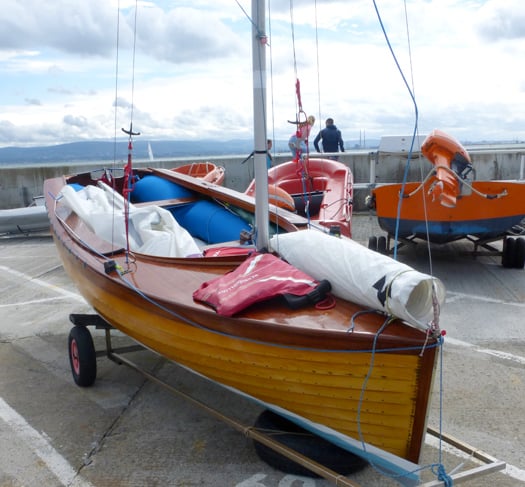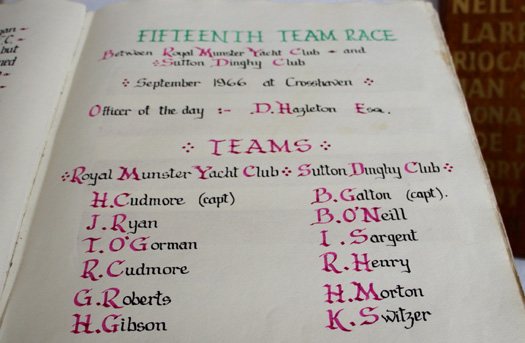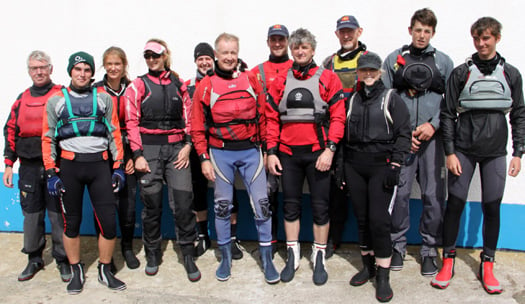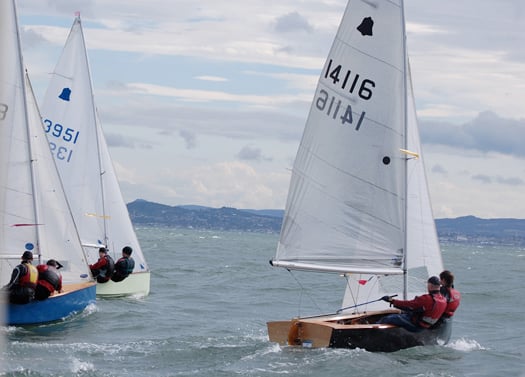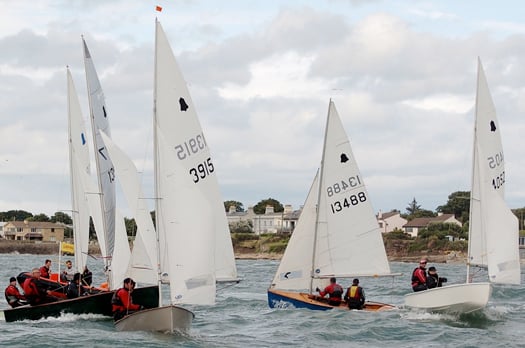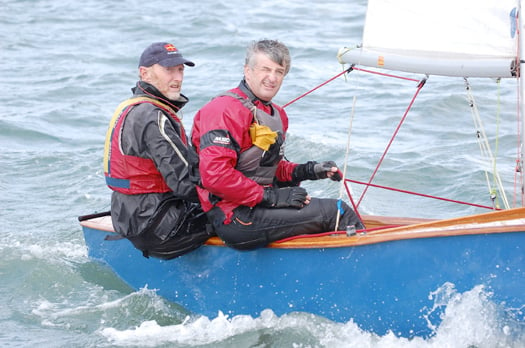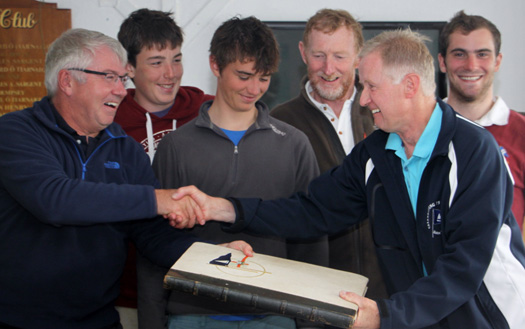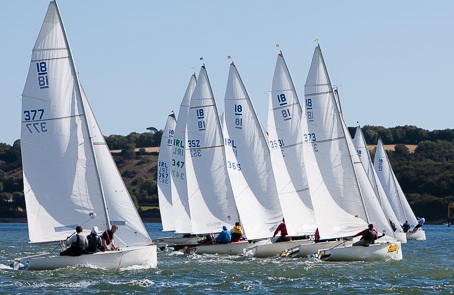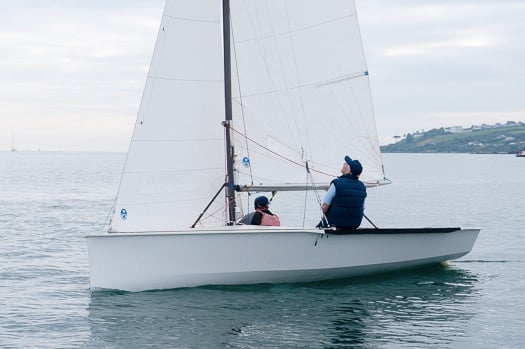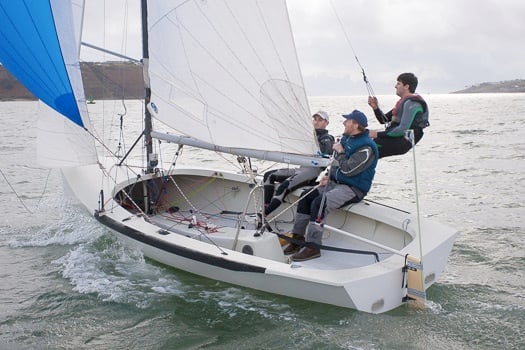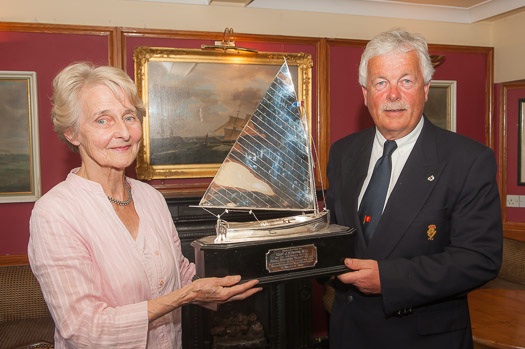Displaying items by tag: WM Nixon
Flying Fifteens & Friends Gather for Annual Prizegiving
The Flying Fifteen & friends annual dinner and prize giving took place at the National Yacht Club at the weekend. The class mustered over 90 for dinner with piano accompaniment Terry Brown who generously provided his talents for a donation by the class to the Dun Laoghaire Lifeboat.
Class Captain Ronan Beirne welcomed the guest of Honour Winkie Nixon of Afloat.ie, Georgina Nixon, Larry Power Commodore of the host club and Commodore Pat Shannon of Dublin Bay Sailing Club. The Captain thanked the Clubs for their support and Mitsubishi Motors for their sponsorship of the class.
In between courses class members gave a short presentation on the fleets activities in the year. Alan Dooley reviewed a busy year with his “flying fifteen health check” resumé. Chris Doorly presented his “Magic Moments” as crew with David Gorman while winning the Championship of Ireland, The Northern and Southern Championships. Alan Green reported on the Worlds in France where he attained a place on the podium with third place.
 Flying fifteen champions David Gorman and Chris Doorly
Flying fifteen champions David Gorman and Chris Doorly
David Mulvin recounted on “The Road to Rhu” and the British Championships which took place on the Clyde.
The guest of Honour Winkie Nixon of “Afloat” gave a most entertaining and informative talk on the talents and life of flying fifteen designer “Uffa Fox”. In addition to the Fifteen he recalled the many other yachts from the board of Fox including the flying thirty five “flying Fox” formerly of the National Yacht Club.
The prize giving was organised by Frank Burgess where some twenty trophies and thirty class medals and six ISA medals were presented. The top class trophy the Championship of Ireland which winners David Gorman and Chris Doorly presented to Larry Power Commodore of the National Yacht Club for safe keeping. The top Dun Laoghaire class trophy the “Heineken Plate” for the best combined Saturday & Thursday results was presented to David Mulvin.
The evening’s formal proceedings concluded with Ronan Beirne passing on the Class Captains Cap to the new Class Captain Joe Coughlan.
New Lease of Life for Vintage Wooden Boats Is a Maritime Highlight
#woodenboats – It's an interesting time for old wooden boats. They may be traditional craft, or classics, or simply ordinary timber boats which have reached a stage in life where they need serious and special attention. Whatever the circumstances, it's clear that their situation strikes a chord with sailors everywhere. And when there's good news about a restoration, it heartens the maritime community to know that worthwhile plans are being implemented. W M Nixon takes us on a tour.
The maritime highlight of this past week was down in the far southwest, at the ceremony in Liam Hegarty's boatyard at Oldcourt above Baltimore on the River Ilen when the "whiskey plank" was fastened in place to complete the hull re-build of the 1926 Conor O'Brien 56ft trading ketch Ilen. It has been a long haul since Ilen was brought back to Ireland from her working area in the Falkland Islands in 1997. Yet somehow, despite all sorts of problems of which the economic recession was only one, the Ilen really is starting to look ship-shape again.
Then in another part of the country, the word had come through that one of the Belfast Lough 27ft S Class sloops, twenty of which were built on the shores of Ballyholme Bay between 1946 and 1963, was facing extinction in a corner of County Louth. The news resulted in a flurry of photos on the Afloat.ie website spurred on by the indefatigable Pat Murphy, and soon the Sorona found herself a new home in a yard in Newry.
There, the story is that she'll be sharing space with the vintage ketch Silvery Light, a substantial vessel built in 1884 on the beach at St Ives in Cornwall to be a herring drifter, and now undergoing a much-needed restoration in Newry after being brought by new owners into Carlingford Lough last Autumn.
Sorona may have been only 52 years old. But her deteriorating condition was a reminder that the climate of Ireland and the seas around us can be merciless to a wooden vessel unless - whether deliberately or by happy accident - the boat is stored in a timber-friendly sheltered environment which is not too hot or cold, nor excessively wet or dry.
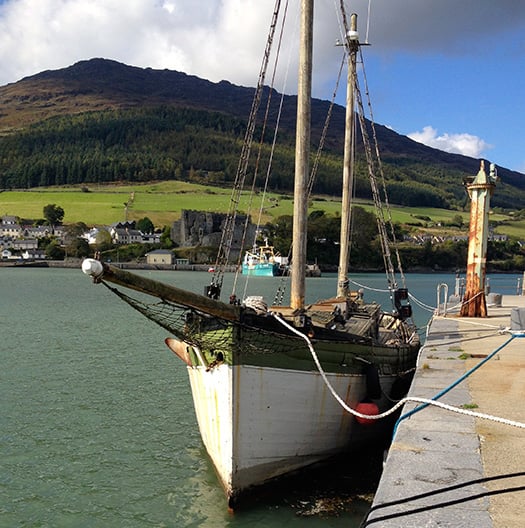 A formidable restoration challenge. The 1884-built ketch Silvery Light – seen here in Carlingford last October – will be undergoing restoration in Newry. Photo: Peter Redmond
A formidable restoration challenge. The 1884-built ketch Silvery Light – seen here in Carlingford last October – will be undergoing restoration in Newry. Photo: Peter Redmond
In the middle of the Irish Sea in the ancient capital of the Isle of Man at Castletown, the 26ft schooner Peggy had survived remarkably well in her harbourside "boat cellar" under Bridge House. In fact, her survival was miraculous, as Peggy was built in 1789, making her probably the oldest yacht in the world. But in recent years, it became clear that a major conservation project was going to be needed to preserve this unique craft.
And just three weeks ago, for the first time in 180 years, the Peggy was removed from her private space in a skilled operation. She is now safely ensconced in a specially prepared conservation workshop in the island's modern capital of Douglas, where it is anticipated the painstaking process of preserving this exceptional gem of maritime heritage could take five years.
Once you have the ideal conditions of micro-climate in place for doing the job, conservation is a long haul, a project of infinite patience. One of the best examples of how it can be done successfully is in Dublin with the Asgard, now on display in Collins Barracks. John Kearon, who learned his shipwright skills in Arklow and then broadened them to include historical work with the Liverpool Maritime Museum, was to lead the team working on this from 2007 until its completion in 2012.
The result is a multi-value display, as the 1905-built Asgard has her place in Irish history through the 1914 gun-running to Howth, she is also totally associated with Erskine Childers which takes us, among other elements in a complex history, into the world of his 1903 best-selling espionage novel The Riddle of the Sands, and she is a marvellous example of the work of the great designer-builder Colin Archer of Norway in creating a very able seagoing yacht of the era, one of the best cruising vessels of her time.
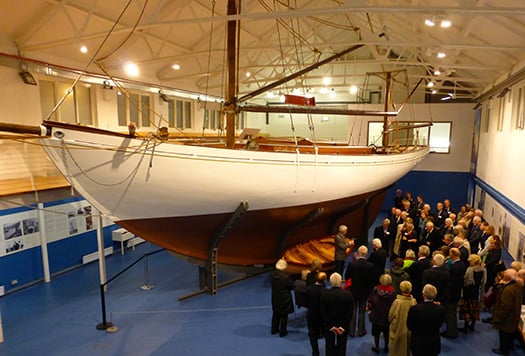
The Asgard in Collins Barracks is a fine example of conservation. A group of Erskine Childers enthusiasts from the Royal Cruising Club is seen here listening intently to a talk by conservator John Kearon about the vessel and the preservation work done with her by his team. Throughout her ownership by Erskine & Molly Childers from 1905, Asgard played a prominent role in the activities of the RCC, and in 1913 their friend Gordon Shepherd was awarded the club's historic Challenge Cup for his remarkable Autumn cruise with Asgard from Norway to North Wales via the Shetland Islands and the Hebrides. Photo: W M Nixon
In her day, the little Peggy was also something of a unique star. Though based in the Isle of Man and most active during the 1890s, she was never in Ireland. Had she been seen on the Irish coast, it would probably have been because she'd been captured by the privateers and smugglers of Rush in North Dublin, who were the capture and contraband industry leaders of their day.
So when Peggy's owner George Quayle (1751-1835) took her "abroad", it was prudently to northern England to race successfully against a small fleet of early yachts on Windermere in the Lake District, though we can be sure that if the men of Rush had come anywhere near him, Quayle would have put up a gallant fight, as Peggy was an armed yacht with miniature cannons which most certainly weren't toys.
But it's the realization that Quayle was active at sea with the Peggy in the years after Luke Ryan of Rush was at his busiest, yet before James Mathews of the same port was at his most active, which helps us to grasp her historical significance. She was sailing the Irish Sea well before the Battle of Trafalgar. But thanks to being immured for a hundred years in her boat cellar after George Quayle died in 1835, this small but significant vessel has survived to become something of extraordinary value today.
Her inevitable deterioration was accelerating in recent years because of mineralization of her fastenings, which were not only consuming themselves, but were damaging all the timber about them. However, her conservation was not something to be undertaken lightly. The provision of a proper facility had to be organised, and then the liftout, clear over the tops of the harbourside houses, had to be planned within inches.
It was all relatively new territory for many of those involved, with much preparatory work. So what had originally been planned as an Autumn 2014 lift finally became possible in late January 2015, just when the weather went to pot, with one gale after another making for impossible conditions. But then one cold Thursday morning at the end of January, the wind maps suggested the arrival of a brief lull in the northwest gales. It arrived exactly on time on a sunny day suggestive of early Spring, and gently but steadily the Peggy emerged.
As Chris Weeks of Manx Heritage remarked as he watched from the parapet above George Quayle's little boat dock, the one thing
they didn't want to hear was any creaking or groaning. If the special lifting cradle was doing its job, the Peggy would rise from her nest of 180 years in perfect silence. And that's exactly how it went, with the lift done in two stages as they were working in very confined streets and spaces.
{youtube}-UyKjwdAhgw{/youtube}
Of course, after all the fuss those of us in the Peggy Appreciation Society have been making for years, when she did finally come into the open the inevitable reaction was: "But she's very small". What on earth did they expect? Something like Nelson's Victory rising up over the old houses of Castletown? How many times do we have to reiterate that she's only 26ft in overall length, just a foot longer overall than a Folkboat, though with greater bulk and a longer waterline.
What her emergence did properly reveal, for the first time in all those 180 years, is just how much the Peggy is a vessel of her era. This is indeed a ship – albeit a miniature one – of the 18th Century. But she's an 18th Century high performance mini-ship nevertheless – this is undoubtedly a vessel well worth conserving.
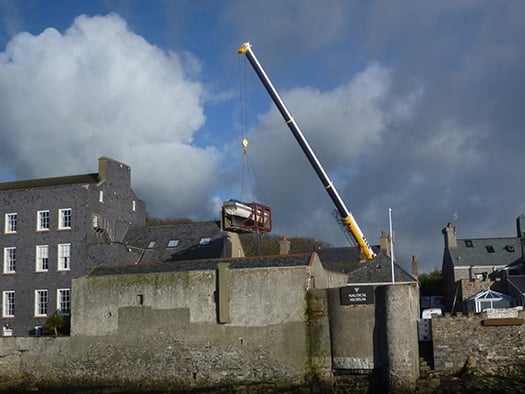
Peggy aloft. The newest crane in the Isle of Man lifts the oldest boat in the Isle of Man. Photo: Michael Kneale
So the day went well. And for those with a technical interest in such things, the word is that the delicate lifting of the oldest boat in the Isle of Man was done by the newest crane on the Isle of Man, a Japanese made Tadano recently delivered (for a cool £550,000) to Mann Crane Hire whose boss Chris Barnes was understandably proud of the smooth work put in by his supervisor Colin Fitzgerald and crane driver David Hooper.
Thanks to their good work everyone was able, for the first time in 180 years, to fully admire and savour the Peggy's lines. To the uninitiated, she may look like just another 26ft clinker-built boat. But for connoisseurs, she's living history with a stylish hull, as she has the most gorgeous hollow waterlines forward, and a sweet run aft – George Quayle had himself a flyer.
 To a casual observer, this may look like just another 26ft clinker-built boat. But for connoisseurs, this is a genuine miniature of a 17th Century ship - the Peggy is very special. Photo: Michael Kneale
To a casual observer, this may look like just another 26ft clinker-built boat. But for connoisseurs, this is a genuine miniature of a 17th Century ship - the Peggy is very special. Photo: Michael Kneale
So it's a bit sad that, as with the Asgard, we have to accept that conservation means the Peggy will never sail again. But thanks to John Kearon's painstaking work, the plans of Asgard as she was originally in 1905 are readily available for any group wishing to build a seagoing replica. Stranger things have happened. And as the Peggy is of such a manageable size, it's even more likely that a new seagoing replica of the little Manx schooner will appear some time, and maybe sooner rather than later. After all, she'd be much the same size as the "new" Shannon hooker Sally O'Keeffe down in Kilrush, which is absolutely on target as a community maritime project.
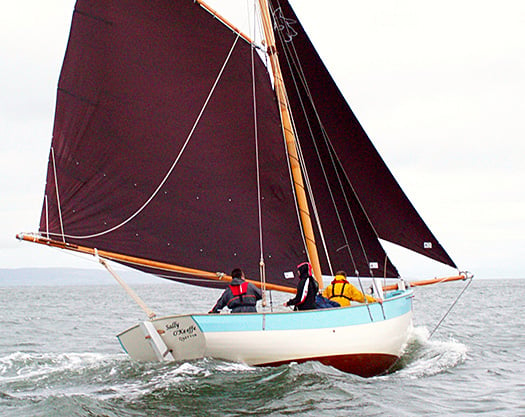
The 2012-built Sally O'Keeffe on the Shannon Estuary is much the same size as the Peggy of Castletown.
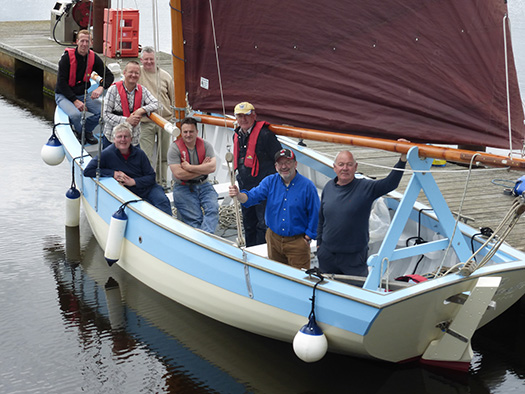 A genuine community project. Some of the team who built Sally O'Keeffe in Querrin aboard the boat in Kilrush with lead builder Steve Morris second left in the trio up forward. Photo: W M Nixon
A genuine community project. Some of the team who built Sally O'Keeffe in Querrin aboard the boat in Kilrush with lead builder Steve Morris second left in the trio up forward. Photo: W M Nixon
Nevertheless after immersing ourselves in the dusty academic topic of proper boat conservation, it's like a breath of fresh air to consider the Ilen, for she will definitely sail again. Tom MacSweeney of this parish was at the ceremony, so we'll defer to himself for his detailed report on the occasion in the fullness of time. But just from looking at the photos, you can get some idea of the quality of the workmanship that Gary MacMahon and his team from the Ilen Trust and Boatbuilding School in Limerick are getting from Liam Hegarty and his shipwrights at Oldcourt.
The pure style of the new planking is a joy to behold. And as for the use of classic bronze spikes for the fastenings, they're a work of the craftsman's art in themselves. Gary MacMahon brought one along to the recent Sail Training Ireland Annual Awards ceremony in the Mansion House in Dublin, and in that setting and on that occasion, you couldn't help but think that if our impoverished nation had been able to utilise bronze fastenings of this standard in Asgard II when building her in the late 1970s, rather than the galvanized steel fastenings that had to be used, then our beloved sail training brigantine might still be sailing today.
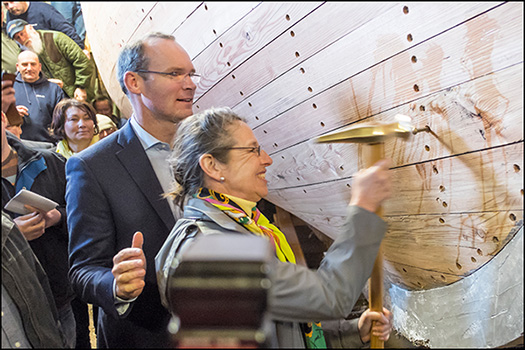
Quality work at every level. The superb workmanship on the Ilen restoration by Liam Hegarty is much in evidence as Minister for the Marine Simon Coveney supports Kate Jarvey of the Ruth Lilly Philanthropic Trust as she drives the bronze fastening to complete the "whiskey plank". Photo: Kevin O'Farrell
But Asgard II is long gone, and so too is Conor O'Brien's Saoirse, the 42ft Baltimore-built ketch in which the Limerick sailor made his extraordinary voyage round the word south of the Great Capes in 1922-25. Thus Ilen is the only tangible link to that remarkable and very historic achievement. For those who enjoy looking at line drawings of boats (not everyone does - there are some who claim that such technical stuff makes them feel "disenfranchised"), it's intriguing to compare the lines of the 42ft Saoirse and the 56ft Ilen.
They're clearly sisters, but you'll note that the Ilen people have made sure that Tom Moynihan of Baltimore is given a significant amount of credit for the design, for down in West Cork they'll tell you that for all that Conor O'Brien was an architect by profession, it took Tom Moynihan's skills to turn his rough concept sketches into vessels capable of sailing so ably across the oceans.

The lines of Ilen as taken off the hull by laser scanner
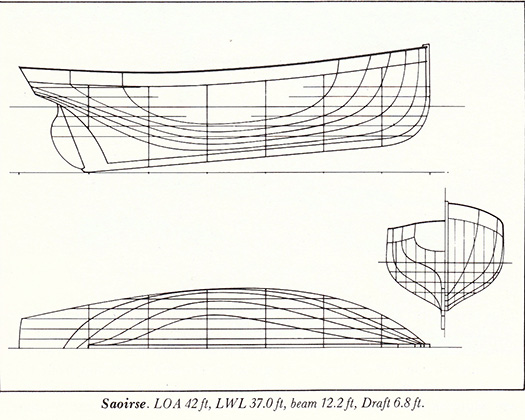
The hull lines of Saoirse as interpreted by Myles Stapleton (designer of Sally O'Keeffe) from basic drawings by Conor O'Brien
An Irish designer who didn't need anyone's help to make his creations look like proper boats was John B Kearney (1879-1967). He may have started his working life as a boy apprentice at Murphy's Boatyard in Ringsend in the early 1890s, while his working life was to be spent with Dublin Port & Docks where he rose to be Superintendent of Engineering Works. But his lifetime ambition was always to be a yacht designer, he trained and studied for it in his very limited spare time from boyhood, and then he worked at it throughout his long retirement. When he finally died at the age of 87, his gravestone in Glasnevin says it all, as it simply reads: John Breslin Kearney.....Yacht Designer. Beloved and respected by all that knew him.
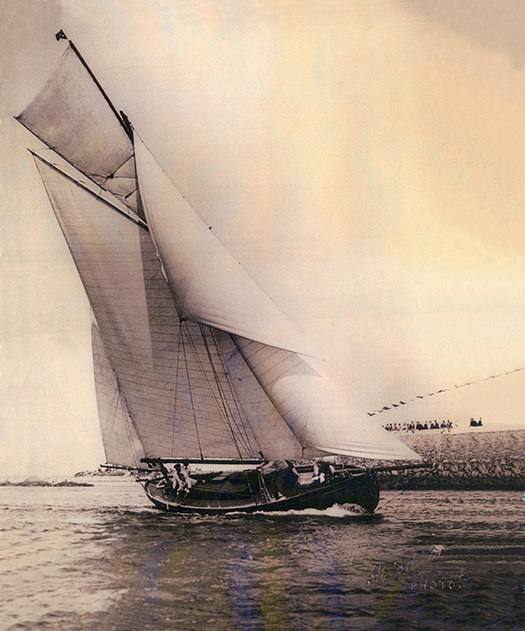
Mavis in her element under Skipper Kearney's command, on her way to winning Skerries Regatta in 1928
For everyone who sailed with him in his many successful cruises and races, he was always Skipper Kearney, and Skipper Kearney's finest creation was the 38ft yawl Mavis which he designed and built himself in Ringsend in 1923-25. Mavis went to America in 1956, and from time to time we've mentioned the continuing process of restoration on her in Camden, Maine, which has been going on for quite a few years now. It has been a lengthy process as owner/restorer Ron Hawkins has to take time out now and again to earn extra funds as a shipwright in order to to keep the Mavis restoration show on the road.
But it's getting there at last. So much so, indeed, that having given the hull of Mavis its first coat of paint in more than twenty years just a couple of weeks ago, Ron and his partner Denise Pukas are now talking of a re-launch date of July 4th 2015 for the restored ship, this treasure of the Irish yacht designer's art and craft.

The quality of workmanship in the restoration of Mavis is clearly displayed. Note how John B Kearney skillfully carried the beam well aft in order to provide a wide and comfortable afterdeck despite incorporating a canoe stern. Photo: Denise Pukas
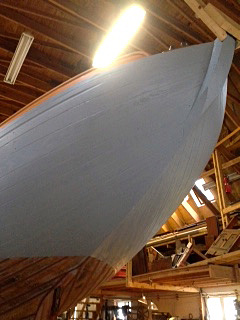
The canoe stern on Mavis with its first coat of fresh paint in 20 years. Here we can appreciate again how John Kearney managed to have an elegant canoe stern while providing plenty of deck space aft. Photo: Denise Pukas
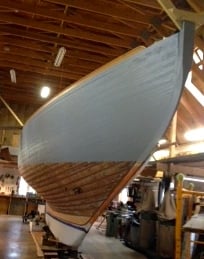
The most famous Kearney hull of all begins to emerge from restoration. It is hoped to re-launch Mavis on July 4th 2015. Photo: Denise Pukas
It would be pleasant to keep this week's commentary on a good news theme right through to the end, but the various emails about saving the Sorona from an untimely end in County Louth brought the information that there are skilled boatbuilders in places like Arklow who are looking for boats needing restoration - not as a commercial venture, but rather as a worthwhile private project.
The secret of it all is surely being able to assess if a particular boat is too far gone to be within your restoration capabilities and resources. Be that as it may, it was sadly ironic to reflect that within yards of the bright and cheerful festival which celebrated the final plank being installed on the Ilen, there's a derelict little boat which would be very rewarding to restore, but it's likely that she's so far gone it's actually a re-build you'd be contemplating.
We're talking of the Englyn, the Harrison Butler-designed 26-footer which came up on the radar last May when were discussing the new 31ft Harrison Butler-designed Khamseen class which Steve Morris, lead builder of the Sally O'Keeffe, is constructing beside his house near Kilrush. But while Steve's boat is starting to look very healthy indeed, sad little Englyn is anything but as she lies abandoned within yards of the Old Cornstore where Ilen is being so beautifully re-born.
Part of the problem in getting anyone interested in the Englyn – which was built in 1934 in Southampton – is that her only link to Ireland was through various owners later in her life. Yet in her day she was considered a classic, so much so that when Eric Hiscock's defining book Cruising Under Sail was published in 1950, Englyn was one of the featured designs. And as the designer Harrison Butler was professionally an ophthalmic surgeon who put heart and soul into everything he did, when Hiscock asked him for the plans he went to infinite pains to bring them to life as a vision of a proper little cruising yacht, even to having a trussed chicken shown in the meat locker.
Over and above that, when looking at Englyn's plans it's not unreasonable to think that, 25 years before Lyle Hess was starting to design his first characterful boats, Harrison Butler was thinking along much the same lines. And he had the boats afloat to prove it.
But that piece of thinking is another day's work. For now, give us a moment of your time to consider the drawings of Englyn as she was in her prime. Then pause briefly to consider sadly how she looked last Monday as Ilen was re-born nearby. And then let's hear it from those who say they're looking for a worthwhile restoration project.

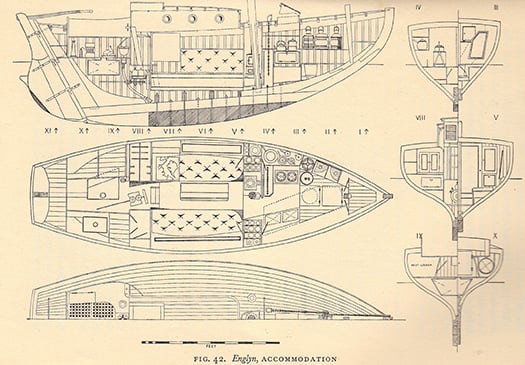
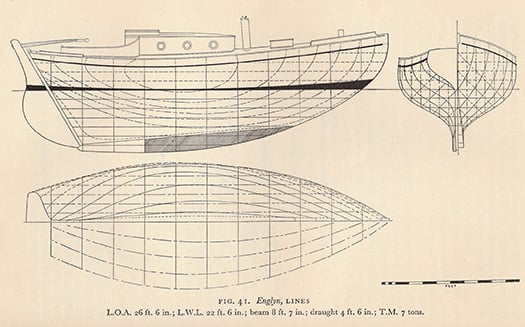
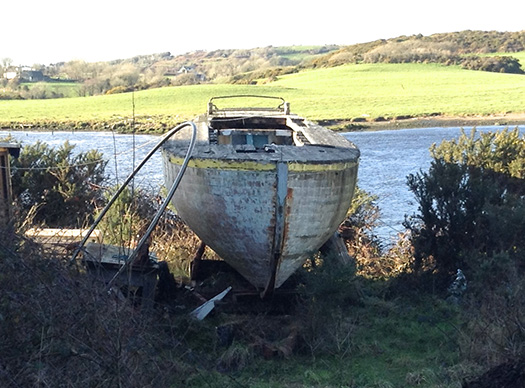
Englyn as she was last Monday at Oldcourt, as the re-birth of Ilen was being celebrated nearby. Photo: John Wolfe
Irish Sailing Review 2014: A Year Of Hope, Regeneration & Success
#irishsailingreview – 2014 has been the year in which Irish sailing regained its international confidence afloat by re-capturing the Commodore's Cup. Having won it in 2010, the national economic collapse prevented any defence in 2012, but in July 2014 the stain and shame of 2012's non-appearance was emphatically wiped from memory with a convincing team victory led by Anthony O'Leary.
Ashore meanwhile, it had taken longer in some quarters for the economic realities to become fully evident and accepted. But for the Irish Sailing Association, a grassroots revolution within the national authority and sailing in general in 2014 resulted in a root-and-branch analysis of the workings of the Association, which had been heading towards financial disaster through a combination of over-staffing, grandiose schemes of expansion and empire-building, and an emphasis on activities and programmes which were remote from the needs of ordinary sailors throughout Ireland.
It took six months to turn round the course of the Association. But on November 5th 2014 the new ISA President, David Lovegrove, was able to announce a far-reaching re-structuring which is already resulting in a leaner and fitter body, better able to provide a realistic service for clubs and the huge diversity of recreational activity on Ireland's seas and lakes.
While all this high profile activity and action has been taking place at international and national level, those Irish sailors who had managed to keep up their sport through the financial downturn – albeit in often very reduced circumstances – continued to sail their boats with the attitude that, while the economic situation was disastrous, it mustn't be allowed to become serious, and in some ways the best course out of the recession was to sail through it. W M Nixon casts an eye over the year's main activities.
In the Irish sailing year, Christmas Day is New Year's Eve. Next morning, on December 26th – St Stephen's Day or Boxing Day or whatever you're having yourself – the annual 628-mile Sydney-Hobart Race starts. It may be on the other side of the world, and it may still be in the very last days of the old year. But Irish interest at home and in Irish-Australia is always high, and in the sailing community it's seen as the start of the new season.
December 26th 2013 was in line with this, as we'd ex-Pat superstar Gordon Maguire – a previous Hobart race overall winner – very much in contention with Matt Allen's totally new Carkeek 60 Ichi Ban, we also had Sean McCarter of Lough Swilly YC skippering Derry/Londonderry in the warmly-welcomed Clipper Fleet of 70-footers designed by Tony Castro (formerly of Crosshaven) which were taking in the Hobart race as part of their global circumnavigating race, and we'd Barry Hurley and Kenny Rumball on the First 40 Breakthrough knowing that in the 2010 Hobart race, the new design's race debut, First 40s had taken first and second overall.
In a rugged race in which the wind got up to gale force and more towards the end, it was a much-loved hundred footer, Bob Oatley's continually-modified Wild Oats XI, which stole all the headlines with line honours, a course record, and a class win. Irish hopes were best met by Sean McCarter, who logged a very clear win in the Clippers. As for Ichi Ban, while she was third in IRC Div 1 and 8th overall, it wasn't quite a stellar performance, reinforcing the views of those of us who think the boat may be just a little too plump by today's lean and hungry standards. And aboard Breakthrough, they'd 8th in class and 29th overall, a useful performance perhaps, but Barry Hurley will be back on December 26th 2014, boosted by his first in class and second overall in October's Middle Sea Race.
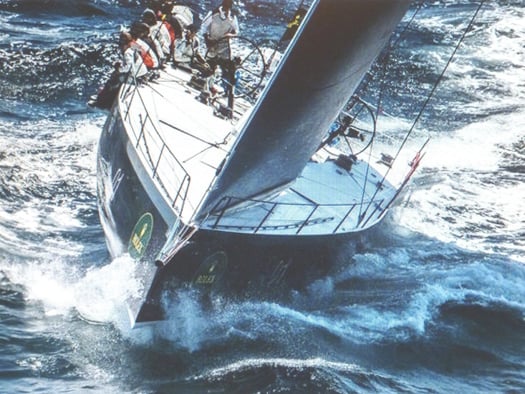
Matt Allen's Ichi Ban in the Rolex Sydney-Hobart Race of 2013, with Gordon Maguire as sailing master. To some observers, the very new Carkeek 60 seemed distinctly plump in her hull form forward compared to her closest competitors
In late January 2014, attention focused on the Quantum Key West Regatta in the Florida Keys, where Irish Olympic sailor Peter O'Leary of Cork was on the strength of New York art dealer Marc Glimcher's completely new and very potent looking Ker 40 Catapult. The boat did the business afloat in Florida, but further business was done ashore, as Anthony O'Leary himself was in Key West to see if he could sign up Catapult to be the secret ingredient in Ireland's Commodore's Cup team, for which at that stage the only certainty was his own older Ker 39 Antix. There seemed to be agreement, but in the volatile world of international trading and snap decisions in which top modern sailing operates, there can be sudden reversals of fortune, and O'Leary later admitted that until Catapult was actually unloaded from a ship in Europe, he hadn't been a hundred per cent certain she'd show.
Key West had further Irish interest in that veteran skipper Piet Vroon's Ker 46 Tonnere de Breskens – a former Round Ireland Race winner – was another star in the show, but much was to happen in Irish sailing before the Round Ireland 2014 got under way in Wicklow on June 28th.
With March slowly showing signs of Spring, university racing came centre stage, and it was University College Dublin which came through on top to qualify as Ireland's representatives in the Student Yachting Worlds in France in October, the team led by Philip Doran.
Another team was emerging as the Irish Cruiser Racing Association (ICRA) announced that our Commodore's Cup squad would be Anthony O'Leary's Ker 39 Antix, Marc Glimcher's Catapult, and the Grand Soleil 43 Quokka chartered by Michael Boyd and Niall Dowling, with Anthony O'Leary as team captain. He in turn would be supported by the shore management team, for a very intense week of racing, of Barry Rose and Fintan Cairns, with Mike Broughton in what would prove to be the particularly onerous task of Team Meteorologist.
As 2014 was exactly midway between two Olympiads, top level international dinghy sailing to Olympic standards might have been expected to be on the back burner. But Ireland's Olympians were very much on track on the international scene, and busy with their own programmes which culminated in the ISAF Worlds in Santander where Olympic places in Rio de Janeiro for 2016 were secured by James Espey in the Laser, Ryan Seaton & Matt McGovern in the 49er, and Annalise Murphy in the Women's Laser Radial. All were of course also seen in other boat types from time to time, with Annalise in particular bringing some glamour to the growing class of foiling Moths in Ireland.
Annalise on the foiling Moth
Other top international women sailors had descended on Ireland in early June with the ISAF Women's Match Race Worlds at Crosshaven. It's very much a specialist sailing interest, but aspiring Irish woman sailors attracted to this discipline found that this successful regatta provided some very useful networking contacts and future crewing possibilities, while the racing itself saw Sweden's Anna Kjellberg of the Royal Gothenburg YC become the new champion after defeating Camilla Ulrikkeholm of Denmark in the final.
In an entirely different area of sailing and life afloat, the traditional boat scene had come early to life with the Baltimore Wooden Boat Festival at the end of May. In the Irish climate after a particularly damp Spring, it reflected great credit on those involved that there was such a good turnout, ranging from the Shannon Gandelows from Limerick recently returned from their historic visit to Venice, through the many restored classic yachts of the region, also including the lovely Shannon cutter Sally O'Keeffe from Kilrush, and going on into the restored traditional mackerel and lobster yawls which make West Cork their home.

Shortly after their historic visit to Venice, the Shannon gandelows built by the Ilen School took part in the Baltimore Wooden Boat Festival at the end of May. The gandelow here, rowed by Liam O'Donghue, Anthony Kenny and Robert Samlle, is headed across Baltimore Harbour towards the gaff ketch Sile a Do.
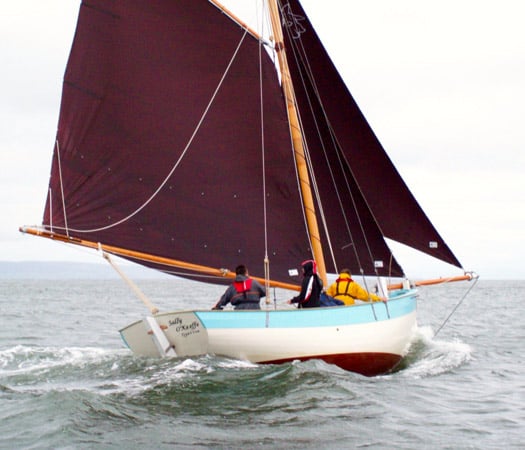
The pride of the Shannon Estuary - Sally O'Keeffe was built in a community effort in Querrin on the Loop Head peninsula.

The traditional lobster boat Saoirse Muireann (left, Cormac Levis) and the mackerel yawl An tiscaire (Uilliam O'Lorcain) are a familiar sight in the waters of West Cork. Photo: Brian Marten
They were to re-appear in even greater numbers at the Ballydehob Gathering of the Boats in early August, a month during which the classic Galway Hookers of the West Coast were at their busiest on their home Atlantic waters, but the East Coast also had its moments with the Riverfest in Dublin's Liffey in early June seeing traditional and classic craft in a lively mix.

Sails in the City – two of the 1898 Howth Seventeens racing in the heart of Dublin in the Liffey Riverfest. Photo: W M Nixon
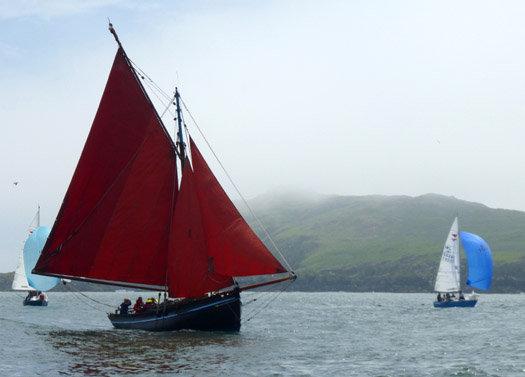
It could almost be Connemara, were it not for the Puppeteer 22s – the Galway Hooker Naomh Cronan in the new Classics & Traditional Division in Howth's annual Lambay Race, which was marking its 110th anniversary in 2014. Photo: W M Nixon
Indeed, so strong is the growing interest in classics and trads on the East Coast that to celebrate the centenary of the Lynch family's Howth 17 Echo (one of the newest of the class, the most senior ones were built in 1898) Howth YC provided a traditional Lambay Race course – simply up around Lambay and back to Howth Harbour – for the Seventeens and a new Classics Division, with the Howth 17s seeing the first two places taken by 1898 boats – Rita (John Curley & Marcus Lynch) and Aura (Ian Malcolm) – while Old Gaffers Association International president Sean Walsh won the classics with his Heard 28 Tir na nOg from the Clondalkin team's Galway Hooker Naomh Cronan. As for the overall prize among the large fleet of more modern boats sailing their more complex course, that was won by Colm Bermingham's Bite the Bullet.
The countdown to the Commodore's Cup had continued with inspirational performances by Anthony O'Leary in the Easter Challenge in the Solent, where he won his class with Antix, and then in June he did the same again with the British IRC Championship. Back home, ICRA held their Nationals with the Royal Irish YC in Dun Laoghaire in mid-June, and out of a fleet of a hundred plus boats it was the vintage Marcus Hutchinson/Rob Humphreys designed Quarter Tonner Quest (Jonathan Skerritt, RIYC) which was best overall scorer, a notably impressive performance also being put in by the Ker 36 Jump Juice (Denise Phelan) from Crosshaven.

The 27-year-old Quarter Tonner Quest (Jonathan Skerritt) was overall winner in the ICRA Nats at the RIYC in Dun Laoghaire. Photo: David O'Brien

Downhill battle at the ICRA Nats with the Mills 36 Raptor (ex-Aztec) in foreground, while beyond is Peter Dunlop of Pwllheli's J/109 Mojito against the XP33 Bon Exemple (Colin Byrne, RIYC). Photo: Davd O'Brien

The Ker 36 Jump Juice (Denise Phelan) dominated Class 0 at the ICRA Nats. Photo: David O'Brien
The end of June, and it was Round Ireland time. Thirty-six boats started from Wicklow, 33 finished in a race which was mostly on the slow side, with mid-size boats having their day. The winner was Richard Harris's Sydney 36 Tanit from Scotland by just six minutes from the home favourite, Liam Shanahan's J/109 Ruth from the NYC in Dun Laoghaire. The French defending champion, Laurent Gouy's Ker 39 Inis Mor which sails in Ireland under the burgee of Clifden Boat Club, placed third while Frank Doyle of Cork, second generation round Ireland aristocracy as son of Denis of Moonduster fame, was fourth with his A35 Endgame.
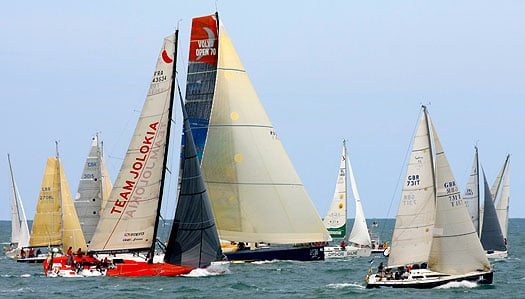
The start of the Round Ireland Race 2014 well illustrates the eclectic nature of the fleet. In right foreground is Richard Harris's Sydney 36 Tanit which was overall winner by just six minutes from the J/109 Ruth (Liam Shanahan), just beyond with the black jib, while the Volvo 70 Monster Project (David Ryan) comes thundering through the fleet at the beginning of a performance whch would see her take line honours win and thd class win in the CK Div.. Photo: Kevin Tracey
The same weekend as the Round Ireland race started, Lough Foyle sent the Clipper Fleet on their way after a week's festivities in Derry/Londonderry, made even more festive by the fact that Sean McCarter and his crew with the home town's boat had crowned their win in the Sydney-Hobart race with victory in the Transatlantic leg to Derry.
Clipper fleet in Derry
Crosshaven fairly leaped to life with Cork Week in July, and after several hitches in various boat-shipping plans, it was notable as the first time the Irish Commodore's Cup Team 2014 were seen together, and mighty impressive they looked too, with Quokka proving best on the Cork Week leaderboard.
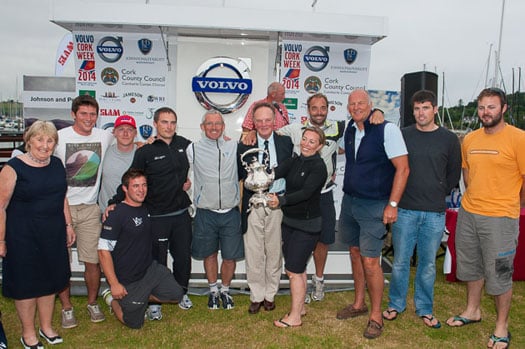
Michael Boyd (centre behind cup) and his Quokka crew, a member of Ireland's Commodore's Cup team, were overall winners of Cork week 2014. Photo: Bob Bateman
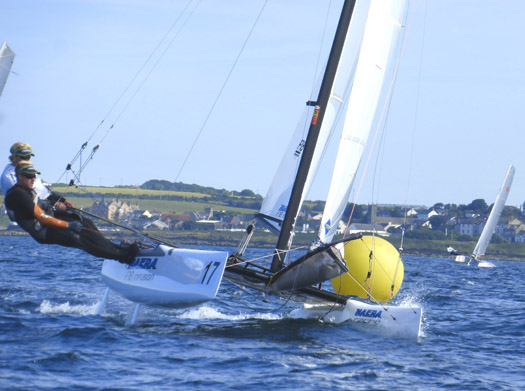
In the F18 Worlds at Ballyholme, Dutch skipper Gunnar Larssen (crewed by Ferdinand van West) is seen here putting in the smooth performance which saw him winning the worlds at his thirteenth attempt. Photo: W M Nixon
While all this excitement in racing boats with lids was building on the south coast in July, up north on Belfast Lough at Ballyholme the F18 Worlds were held for one of global sailing's most popular catamaran classes. Though the entry of 56 boats didn't match the 150-plus entries they get when the class has its worlds in its Mediterranean heartlands, the sailing was good and a popular winner emerged in longtime F18 sailor Gunnar Larsen, who is Dutch despite his Scandinavian name.
Dinghy attention was also very closely focused on Dublin Bay, with an enormous fleet of Optimists at the Europeans hosted by Royal St George YC from 12th to 20th July, and Dun Laoghaire really showing what it can do in being a major international regatta centre. France's Enzo Balanger was tops from Sweden's Kasper Nordenram, while best of the Irish in the Gold Division was Royal Cork's James McCann in tenth – not surprisingly, he was to go on to win the Nationals at his home club in August.

Nations from across Europe and beyond were at the Optimist Euros at Dun Laoghaire

Finn Lynch racing at Douarnenez in France where be became the new U19 Laser Standard world championPhoto: Trevor Millar/Sail Coach
On the broader international scene, former Opty stars Finn Lynch (National YC) and Seafra Guifoyle (Royal Cork) were to turn in outstanding results during 2014, with Guilfoyle firmly in the frame through the ISAF Youth Worlds in the Laser, eventually coming home from Tavira in Portugal with the Silver, while Finn Lynch was on top form to clinch the Gold in the Under 19 Laser Standard Worlds at Douarnenez in Brittany.
Back aboard the boats with lids, late July had brought the Commodore's Cup in the Solent, and if anyone out there doesn't know who won, we'd like to hear from them, as the state of total seclusion which this implies is surely something which could be packaged and marketed to our hyper-informed and over-crowded world. The comprehensive Irish victory just seems better and better with the passage of time, and for Anthony O'Leary it was the highlight of a fantastic season which in September was to see him win the Helmsman's Championship of Ireland (admittedly by just a whisker) in J/80s in Howth to set up a national double for Royal Cork, as young Harry Durcan of Crosshaven was winner of the Junior Helmsmans. O'Leary meanwhile went on to win the 1720 Nationals in Baltimore later that month, and then in November his beloved Antix was named RORC Yacht of the Year.

Antix in the Commodore's Cup, hanging in well coming to the weather mark to stay ahead of the newer Ker 40 Cutting Edge. Photo: Rick Tomlinson)
Even as Antix and her team mates were racing on towards glory in the Solent, in Clew Bay the West of Ireland Offshore Racing Association (WIORA) were staging their annual championship at hospitable Mayo SC, and it saw a good spread of results, with the overall winner being Galway's Liam Burke with his Corby 25 Tribal, while the runner-up was the McGibneys' Dehler Optimum 101 Dis-a-Ray, which sails under the Foynes YC burgee, but her home port is Tarbert further west along the Shannon Estuary.
August was busy with events for enjoyment. Eighty boats raced in Calves Week in West Cork, which has now been compressed to a four day regatta which means, as one sage family man observed, that you can take a house in Schull for a week's holiday, and then just as the wife and kids are getting fed up with having the ould fella always about the place, doesn't he absolutely have to go off and spend the last four days of the holiday sailing with his mates? That one of the top boats was Colman Garvey's True Penance maybe says it all.

Calves Week 2014 entries were up 25% in 2014. Photo: Bob Bateman

The GP14 Worlds at East Down YC in Strangford Lough launched a hundred boats every day in smooth style. Photo: W M Nixon
The biggest dinghy event of all (other than the Laser Nationals, which as ever are in a league of their own) was the GP 14 Worlds in mid-August at East Down YC in Strangford Lough, which had its excitement in a sudden storm on the Monday, but it all turned out okay. Boats involved were just over the hundred mark, the best boats were built in Northern Ireland by Alistair Duffin, and winners were English crew of Ian Dobson and Andy Tunnicliffe from Burwain, while top Irish were John and Donal McGuinness of Moville in Donegal, they were sixth.
At the other end of the intensity scale, down in Howth they had their first cruiser-racer two-hander for the Aqua Restaurant Challenge. Despite very restrained pre-publicity, it attracted 34 boats for a race round Lambay and the Kish. Stephen O'Flaherty's elegant Spirit 54 Soufriere, fresh from a win in the Panerai Classics in Cowes and co-sailed by David Cagney, took line honours and almost won, but the vintage Humphreys Half Tonner Harmony (Peter Freyne and Jonny Swann) just pipped them at the end.
Sailed in summery weather, the new Howth two-handed was about as different as possible from another two-handed experience in August, that of Liam Coyne (NYC) and Brin Flahive (Wicklow) in the 1800 mile RORC Seven Star Round Britain and Ireland. They didn't have to be two-handed, there were fully crew boats involved including the 70ft–trimaran Musandam in which Ireland's Damian Foxall played a leading role in taking line honours in record time, but aboard the First 36.7 Lula Belle the Irish duo just toughed it out despite sailing the last 500 miles with virtually nothing functional, they simply decided to see it through, and to their amazement found they'd won Classes V & VI.
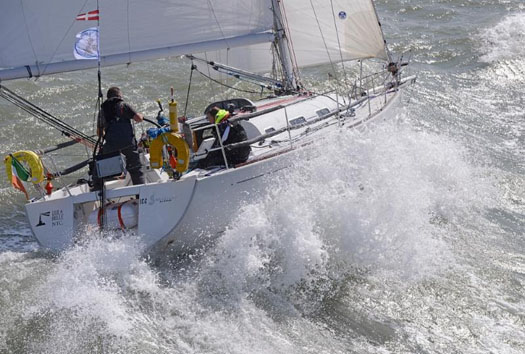
Lula Belle on her way out of the Solent with 1800 miles to race. Photo: Rick Tomlinson
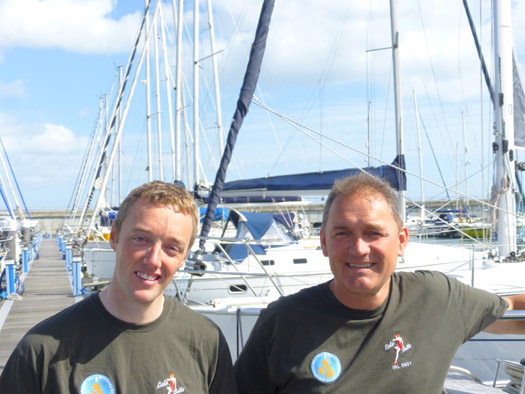
Brian Flahive & Liam Coyne back in Dun Laoghaire on the morning of their return from the finish of the Round Britain & Ireland Race. Photo: W M Nixon
As for the Laser Nats, they were at the end of August and another Ballyholme event, with Johnny Durcan of Royal Cork winning from Rory Fekkes of the home club, while the radials saw Annalise Murphy keep her hand in with a win from Cork's Cian Byrne.
After some rugged August weather, particularly on Ireland's East Coast, September was utterly blissful and it sweetly rounded out Dublin Bay Sailing Club's 130th season, the birthday being marked by a fairly epic dinner in the National YC. September also saw the conclusion of the slowly but steadily reviving Irish Sea Offshore Racing programme, with the end-of-season race from Pwllheli to Dun Laoghaire seeing Liam Shanahan's J/109 Ruth confirmed as the overall winner of the series. Among locally campaigned dinghies, meanwhile, Dun Laoghaire's keen Fireball Class kept its annual programme in lively shape, and the season drew a close with Barry McCartin and Conor Kinsella winning overall from Noel Butler and Stephen Oram.

ISORA Champion Ruth skippered by Liam Shanahan jnr from the National Yacht Club
Across country in Limerick, the CityOne dinghies and the traditional Shannon gandelows created in projects of the Ilen Boatbuilding School made their debut in the city centre on one of the last days of the Indian summer, and then they were put on display in a Naumachia in St Mary's Cathedral which was officially opened by Michael Noonan TD, and later formally visited by President Higgins.
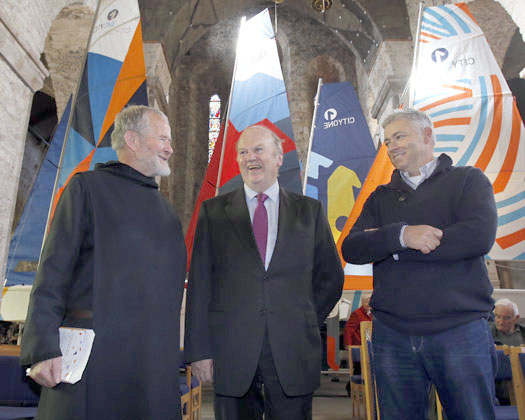
The hopeful new spirit of Irish sailing in 2014 was evident in St Mary's Cathedral in Limerick, when the CityOne dinghies built by volunteers in an inner city revitalisation project went on display in a Naumachia in the Cathedral on September 26th, after their first regatta on the Shannon in the heart of Ireland's City of Culture 2014. With the boats in the cathedral were (left) Brother Anthony Keane of Glenstal Abbey (Director, the Ilen School), Limerick's senior TD and Ireland's Minister for Finance Michael Noonan, and Gary MacMahon (right) Director of the Ilen School & Network for Wooden Boatbuilding. Photo: Press22
And then more vigorous winds returned in October, with the Freshwater Keelboat event on Lough Derg – originally just an exclusive Dragon thing – finding itself swamped with sixty and more boats from five classes and increasingly rugged conditions, such that only the Dragons and Squibs managed to get in any meaningful racing, with Neil Hegarty (RStGYC) winning the Dragons while James Matthews and Rob Jacob of Kinsale topped the Squibs.

Dragons in Autumn action on Lough Derg – Neil Hegarty (right) was overall winner from runner-up Richard Goodbody (left) Photo: Gareth Craig
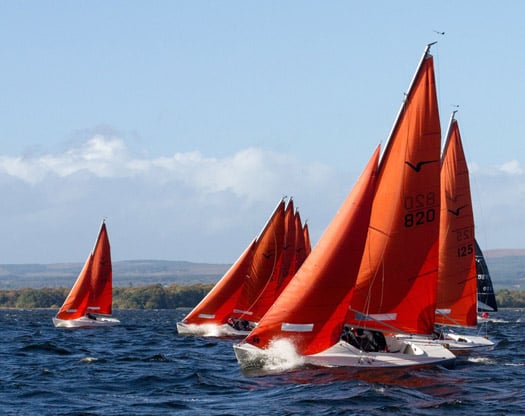
Squibs on Lough Derg – it may look like perfect sailing, but the top came off the weather very soon afterwads. Photo: Gareth Craig
The Student Yachting Worlds in La Rochelle in October had some hiccups in UCD's campaign for Ireland, but while they very narrowly missed the podium in a truly international event, they stayed put at fourth overall. And round in the Mediterranean, a record fleet for the Rolex Middle Sea Race from Malta saw entries soar through the 120 mark for the first time, and the 606 mile race had its first half in light breezes, but the second half was in pure Mistral, with people talking of "winds easing to 44 knots....." A Maltese-owned J/122 won, but second overall and first in her class was the Xp44 XpAct (Josef Schultheis) with a strong Irish emphasis in her crew including Barry Hurley, Andy Boyle, Kenny Rumball and Phillip Connor.
Soon afterwards, the Volvo World Race got under way with first stage from the Med to Cape Town, and Ireland's Justin Slattery on the winning boat on Leg 1. Back home, Autumn leagues had seen renewed enthusiasm as though people had suddenly re-discovered their sport, and the great sailing year of 2014 drew towards its close with the Lasers in Howth starting their 40th winter of annual frostbite racing. This means that HYC have now had a continuous sailing programme since April 1974, while across in Dun Laoghaire the DMYC Frostbite Series must be the most senior of all winter events. Winter Leagues attract more aficionados, with the popularity of the Dublin Bay Turkey Shoot in particular providing a forceful reminder that Dun Laoghaire is the principal sea access for a notably affluent and very large population in South Dublin. With the Turkey on its way, soon it's Christmas. And then the new Irish sailing season will begin on the blue waters of Sydney Harbour.
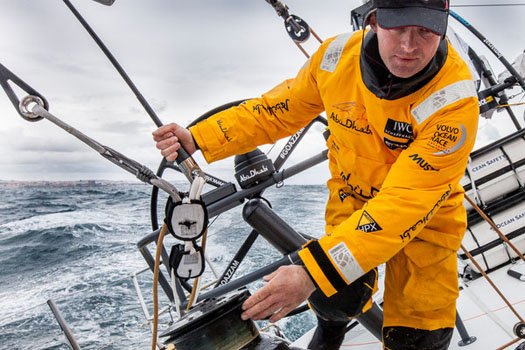
Justin Slattery on Volvo World Race 2014. Photo: Volvo Ocean Race
What's The Way For Dublin Bay's Classic Boat Sailors?
Last week's Sailing on Saturday blog about the fate of classic yachts was a revelation about our readership. Although three significant historic vessels in three different and distant locations were involved, it was the news about the re-build of the Dublin Bay 24 Periwinkle which drew nearly all the attention. Cork Harbour may indeed be the true capital of Irish sailing, but the sheer size and wealth of the South Dublin population accessing the sea through Dun Laoghaire gives it special power and interest. As someone whose home port is outside Dublin Bay, W M Nixon happily returns to the fray.
It's little wonder that Ireland has won more than her fair share of Nobel Prizes for Literature, yet frequently has to look abroad when boats need to be built. We're great at working words into packages of merchandisable literature or high-flown arguments, but we're maybe not so good at building boats, or even looking after them.
But then, Albert Einstein was a keen sailing man, yet despite his intellectual genius, his boat was always a bit of a mess. So maybe it's all of a piece, that last weekend's story about – among other things – the re-build in France of a classic Dublin Bay 24 of 1948 vintage, has in the space of a few days evoked thousands of beautifully-crafted words in the comment section with enough heat generated to warm a small town. (to read comments scroll to the end of last Saturday's blog here – Ed)
Some of the big beasts of Dun Laoghaire's sailing jungle have enthusiastically thrown their hats into the ring, and already we can imagine some shrewd producer of Cable TV docu-dramas setting out a potential cast list for the likes of Roger Bannon and Hal Sisk, while the mysterious Michael Joseph will be played by The Man In The Iron Mask.
The irony of it all is that all these commentators aspire to the same thing – increased vitality and enthusiasm in Dun Laoghaire sailing. And sometimes, if they would take more time to read each other's detailed comments, they'll find they broadly are advocating the same methods of providing boats which will set the local sailing imagination alight, rather than being just another set of plastic fantastics.
But because of the Irish habit of "wanting nothing to do with that other crowd," a lot of creative diplomacy is needed to harness all this energy. Maybe an intense level of debate is unavoidable. For as we've said of another venerable Irish classic boat class which manages to survive and prosper, it does so by inverting the laws of physics, and relying on friction to create energy.
Let's begin with the most straightforward query – Michael Joseph's first question, posted on Wednesday 15th October, as to why do we think that the setup in Dun Laoghaire is not conducive to the preservation and continuing vitality of a class of 38ft classic wooden yachts, in other words the Dublin Bay 24s?
Well, basically it's because Dun Laoghaire has great difficulty in getting some of its acts together. It's physically a very fragmented sort of place. The relationship of the town with the harbour has always been problematical, and it's difficult to generate a general sense of maritime community which might be conducive to encouraging classic yachts which need to be well loved.
When the plans for the new "Asylum Harbour" were drawn up in 1817, it was seen purely as a shelter facility for shipping caught out in in adverse weather in the Dublin Bay. Although there was a tiny quay at Old Dunleary (the area is still known as The Gut), in the initial plan it was actually shown as being outside the new harbour. The thought that the crews of ships anchored in this new port of refuge might wish to have direct contact with the nearest bit of shore seems if anything to have been actively discouraged.
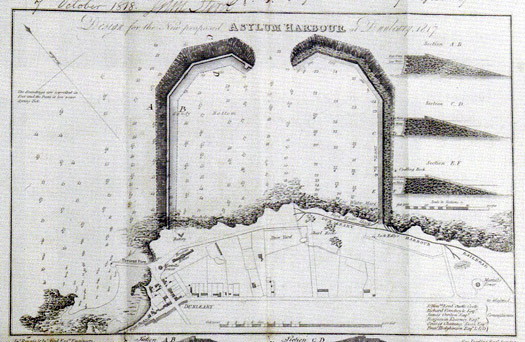
The proposed pans for an Asylum Harbour in 1817 did not include any suggestions as to possible in-harbour locations for jetties and quaysides, let alone waterfront development, and it actually excluded the small quay at Old Dunleary to the west, though in the final form the West Pier was moved further west to enclose the Old Dunleary pier.
This meant that when the inevitable shoreside facilities began to develop rapidly, it was all on a piecemeal basis. Ideally, when the plan for the harbour was finally agreed, a parcel of property of the same area as the harbour itself should have been secured on the waterfront for the planned development of a complete harbour town. But instead, you got opportunist growth - not really development at all. An unattributed quotation about 19th Century Kingstown, as it had now become, in David Dickson's recently published mighty tome Dublin (Profile Books) tells us much about the official view of the way things had got out of hand in the new seaside town, with speculative developers such as Mr Gresham from the Gresham Hotel putting up terraces of houses every which way:
".....no system whatever has been observed in laying out the town so that it has an irregular, republican air of dirt and independence, no man heeding his neighbour's pleasure, and uncouth structures in absurd situations offending the eye at every turn."
Ouch. For a growing conurbation which prided itself on being called Kingstown, that "republican air of dirt and independence" was a low blow. But as the new railway in 1834 had cut most of the new town off from the sea, an effect which was to become further emphasized by roads running parallel with it, the opportunities for dynamic interaction between town and harbour were restricted. Thus any waterfront space became too valuable to house the workshops of master craftsmen, boatbuilders and shipwrights who might be expected to be readily available to build and maintain local classes of wooden yachts of any significant boat size.
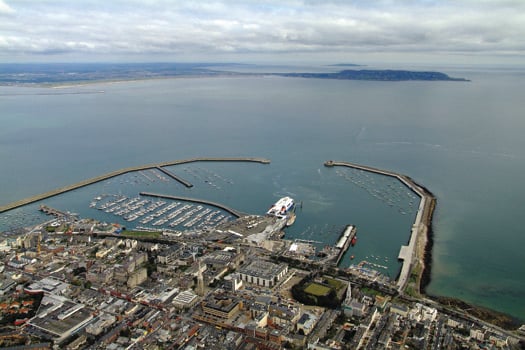
Modern Dun Laoghaire looking northwards, though it should be noted that this photo was taken before the contentious new library was forced into the waterfront between the Royal Marine Hotel and the National Yacht Club. With the water edge's almost exactly marked by the railway and the roads parallel to it, this clearcut division means that, far from the waterfront being part of a shared urban-harbour complex, the complete lack of planning in the early stages has resulted in very little comfortable inter-action between harbour and land, and there is precious little space available for locating specialist small boatyards and marine workshops which would facilitate the continuing good health of substantial wooden classic yachts.
So nowadays, the reality is that basing a cabin sailing yacht of any reasonable size in Dun Laoghaire on a year round basis is too expensive already without the added cost of her being a high-maintenance classic. The best value for money in Dun Laoghaire at the moment is probably provided by a Sigma 33 or a First 31.7 raced as a One Design. Yet in both cases, the necessary membership of one of the waterfront yacht clubs and Dublin Bay Sailing Club, added to the expense of a marina berth and the most basic running costs, means an owner-skipper is shelling out around €10,000 per annum before anything much has been done with the boat.
So although Dublin Bay Sailing Cub works wonders in co-ordinating the racing of hundreds of boats, the survival or otherwise of a class is dictated not by policy decisions on promoting new classes by DBSC, but rather by ruthless market forces, with the sheer expense of sailing from Dun Laoghaire dictating which classes can hang on when times are bad.
The result is that over the years, the surviving classics have become steadily reduced in class numbers, and only the smallest boats survive. With the loss this year of the 17ft Mermaids as an officially recognized Dublin Bay class, as they could no longer guarantee the minimum fleet of five boats, only the 25ft Glens survive from the former serried ranks of several wooden keelboats, and only the 14ft Water Wags survive of the once numerous wooden dinghies.
Yet the growing health of the Water Wags – which can trace their history back to 1887 as the world's first One Design Class - suggests that even in the cut-throat accountancy-led world of Dun Laoghaire Harbour, people still have a natural fondness for classic wooden boats. The current fleet of robust Water Wag dinghies are to a design adopted in 1904, and it adds to their attraction that although they were supposedly designed by local boatbuilder James Doyle, it's generally agreed that the real designer was his talented daughter Maimie.
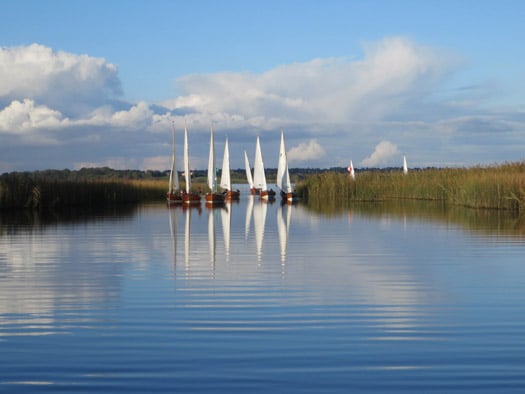
Mind the gap........ Some of the fleet of a dozen and more classic Waterwags which departed their home waters of Dublin Bay last weekend to race in County Roscommon on the North Shannon's Lough Boderg. Photo: Guy Kilroy
The class have an instinctive sense of their own community, with mutual assistance in maintenance and honing sailing skills a natural part of the healthy mix. One of the factors which has increased their viability is the huge improvement in boat road trailers, for although they remain firmly based in Dun Laoghaire, from time to time you find they've upped and left and gone off for a weekend's racing at some strange and distant location, which might well be described by the management wonks as a bonding exercise
Last weekend, they were having their annual North Shannon Regatta. One of the keenest owners, Guy Kilroy, has a farm in Roscommon on the west shore of Lough Boderg, and the Water Wags descended on him in force. Despite the presence of the great Jimmy Furey building his classic sailing dinghies at Leecarrow on the west shores of Lough Ree, you'd never have thought of Roscommon as a sailing county, but there you go. However, while the coastal Autumn leagues at Crosshaven and Howth saw the seasonal mists soon dispersed, on Boderg in the middle of Ireland it took a long time for the fog to lift. But when it did, the sailing was sublime, and they got in two good races, with four boats level on points, but Ian and Judith Malcolm in the 99-year-old Barbara won on the countback.
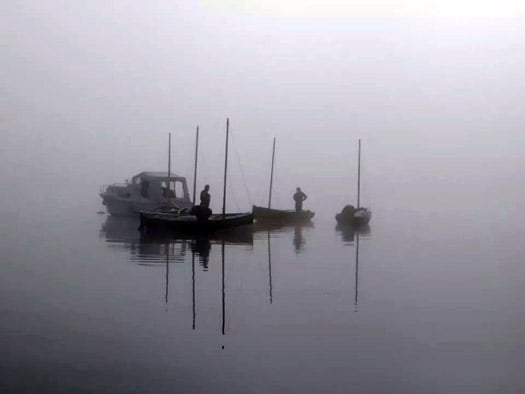
Wags-in-a-mist. While the seasonal mists soon cleared at the Autumn Leagues on the coast at Crosshaven and Howth, in the heart of Ireland on Lough Boderg the fog lingered. Photo: Judith Malcolm

Lots of TLC. They may be in the reeds, but the maintenance mustn't be done in a rush.....The high standard of TLC on the Water Wags – the oldest chime in at 110 years – is a wonder to behold. Photo: Ian Malcolm
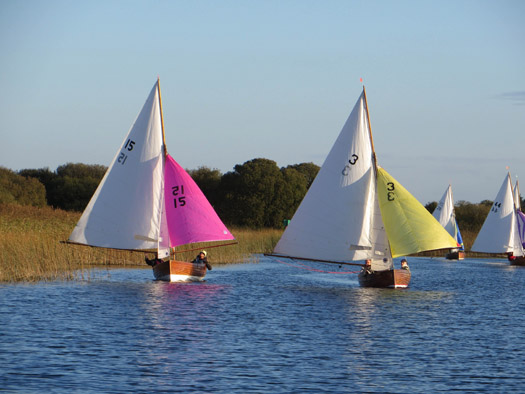
When all the loving care becomes worthwhile – perfect racing on Lough Boderg last weekend for David McFarland's Moosmie (15) and Vincent Delany's Pansy (3), with Killian Skay's Maureen (29) and Scallywag (44, David Williams and Dan O'Connor) in gentle pursuit. Photo: Guy Kilroy
Maintaining a Water Wag is a very manageable business, but inevitably as the recession recedes, there'll be noises about reviving larger wooden classics, and there's a feeling that the Mermaids aren't completely finished in Dun Laoghaire harbour just yet. There was an interesting twist to this in 2014's Mermaid racing, as the National Championship at Rush was won by Jonathan O'Rourke of Dun Laoghaire's National YC.
Despite being up in Fingal's Rogerstown heartlands where in recent years they've built some supposedly hyper-competitive Mermaids with the clever use of epoxy, Skipper O'Rourke's boat is the 1960 Grieves Brothers built Tiller Girl, which is surely a hopeful sign for the class's future.
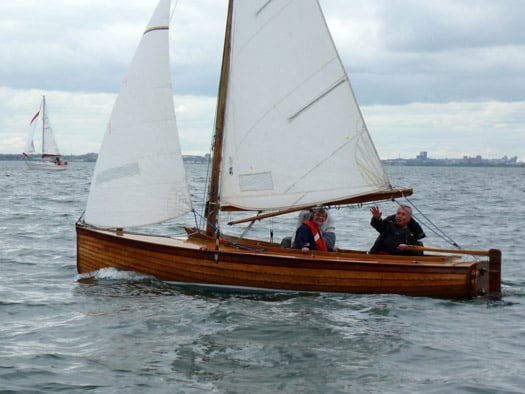
The age-defying champion. Mermaid Champion 2014 Jonathan O'Rourke (National YC) with his 1960-built Grieves Brothers boat Tiller Girl. Despite there currently being no racing for Mermaids in Dun Laoghaire, Tiller Girl won the Nationals at Rush even though she was in the area where new supposedly lighter Mermaids, using the exoxy wood system, have recently been built. Photo: W M Nixon

Well, hello Dolly! Named after the world's first cloned sheep, the cloned GRP Mermaid Dolly (white hull) was built in the hope of revitalizing the class, particularly in Dun Laoghaire. But even though she only had a fiberglass hull shell with the rest of her – including the mast – in wood, the new concept was rejected by the class. So Dolly is now based at Sag Harbor in the Hamptons on Long Island in America, where she is much admired, while three of her sisters have proven very to be very durable and effective training boats at a sailing school in West Cork.
Nevertheless, it's at this time of the year that the hassle of maintaining a clinker built wooden boat comes centre stage yet again, and I have to confess that when Roger Bannon produced the fibreglass-hulled Mermaid Dolly, I thought she was a super boat and still do, but the class elders decided otherwise.
Moving on up the size scale, we return to the battleground of the Dublin Bay 21s, still mouldering in a Wicklow farmyard. I only once sailed on one of them under their classic gaff rig complete with jackyard topsail, and despite the enormous spread of cloth, was very impressed by how light and responsive they were on the tiller, but then we were racing in a gentle breeze.
The Dublin Bay 21s await their fate in a Wicklow farmyard
However, this constant refrain about them acquiring dangerous lee helm in strong winds seems to me to be a result of the primitive mainsail arrangement, with the tail of the mainsheet led directly from the counter to cleats on the cockpit coaming. This gave very poor levels of sail control in squalls, and often when the helmsman requested that the mainsheet be quickly but carefully eased to give him better control and keep the boat more upright, it would instead be let go with a run, the mainsail would then be flogging out of control, the close-sheeted headsails would force the bow off, the end of the long mainboom would then hit the water causing the sail to fill with the boat now on a reach, and over and under she'd go.
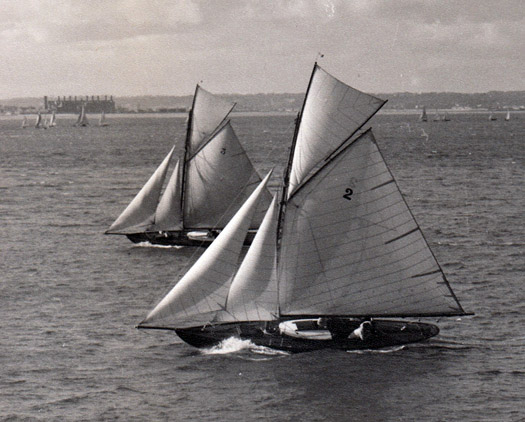 In a moderate breeze, the Dubin Bay 21s under their original rig undoubtedly carried a small amount of weather helm, and there was no evidence of lee helm at all.
In a moderate breeze, the Dubin Bay 21s under their original rig undoubtedly carried a small amount of weather helm, and there was no evidence of lee helm at all.
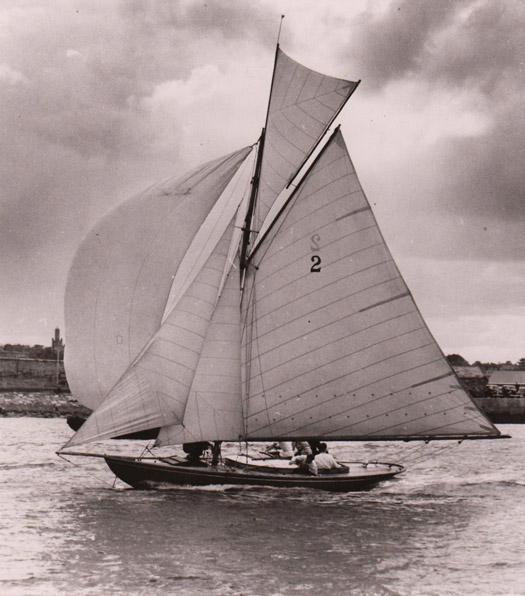 Dublin Bay 21 at full cry in the final short in-harbour run from the Coal Harbour buoy to the finish off the club. For this crucial little leg, instant spinnaker setting was essential. It can be noted that the crewmember on the right in the cockpit is trimming the mainsheet by looking aft, the sheet being cleated to the cockpit coaming. In severe weather, this crude method of sheeting could sometimes see the entire sheet being let go completely out of control, whereupon the boat's bow would be forced off by the still-sheeted headsails, the main would then partially fill on the reach as the hyper-long mainboom had started to trail in the sea, and the risk of sinking became very real.
Dublin Bay 21 at full cry in the final short in-harbour run from the Coal Harbour buoy to the finish off the club. For this crucial little leg, instant spinnaker setting was essential. It can be noted that the crewmember on the right in the cockpit is trimming the mainsheet by looking aft, the sheet being cleated to the cockpit coaming. In severe weather, this crude method of sheeting could sometimes see the entire sheet being let go completely out of control, whereupon the boat's bow would be forced off by the still-sheeted headsails, the main would then partially fill on the reach as the hyper-long mainboom had started to trail in the sea, and the risk of sinking became very real.
So it could well be that if a re-built class of Dublin Bay 21s ever emerges, that then they might be given an added safety factor by having the mainsheet led forward, guided close along the underside of the mainboom, and then come down the aft side of the mast to be controlled by a winch on top of the coachroof.
As to whether or not we'll ever see the 21s race again, the odd thing is I think this week's intense exchange here on Afloat.ie may have brought it all a bit nearer. Because if you plough on through the icy politeness of the initial exchanges between Hal Sisk and Roger Bannon, I think you'll discern that they both reckon a cold moulded multi-skin timber hull construction to be a very viable option.
Roger Bannon points out that building a completely new hull on the ballast keel of the original boat is recognized under maritime law as being the continued existence of the same boat, which somehow is an oddly heartening bit of information when you look at the utter dereliction of the DB 21 hulls today.

Could this be the future for the Dublin Bay 21s? Beautiful multi-skin construction under way on Steve Morris's 32ft Harrison Butler designed classic at Moyasta near Kilrush. If it's adopted for the revival of the Dublin Bay 21s, as several of the boats would be buit in one batch construction could be facilitated by the inverted hulls being built on a male mould, thereby making the work easier for newcomer to boatbuilding working on a community basis.
Photo: W M Nixon
And as for Hal Sisk and Fionan de Barra, they've been considering seriously the work being done by Steve Morris near Kilrush in building a cold-moulded classic cutter to Harrison Butler's Khamseen design. Steve was the lead builder in constructing the superb gaff cutter Sally O'Keeffe down in West Clare. So when you see his work on his new boat, all things seem possible, particularly if it's agreed that the new Dublin Bay 21s should be cold-moulded in multi-skin timber on inverted hulls in a maritime community project in Dun Laoghaire, as the basic work would be relatively unskilled, and everyone could have a go at it.
For, as the success of the wonderful CityOne dinghy project in Limerick has shown, in sailing the building of the boat can be as much part of the experience as the subsequent time afloat. But if we ever do see the Dublin Bay 21s sailing again, let it please be with the proper rig. Everyone seems to be pussy-footing around the idea of a more easily handled semi-gunter configuration, maybe with just one jib. What's the point of all that? This isn't meant to be Easy Street. Let's have the full jackyard tops'l and cutter rig and all the bells and whistles, or let's not bother at all.
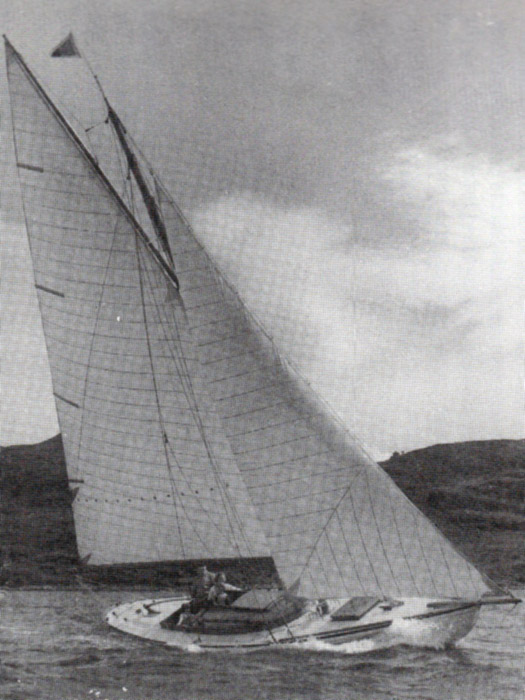
Should the Dublin Bay 21s be re-built, it has been suggested that for ease of handling and project management they might in future use this simpler "American gaff" rig, as seen here on Zanetta which was built on the Clyde in 1918 to the Dublin Bay 21 design.............

,,,,,but here at Afloat.ie, we reckon that would be the wrong approach. If you're going to have a new Dublin Bay 21, then she should have all the classic bells and whistles and more sail than is good for her, just as we see here with the Ringsend-built Innisfallen having a bit of sport with her spinnaker in the 1950s.
Who Runs Dublin Bay, The Capital's Waterborne Playground?
#dublinbay – Who runs Dubli Bay? Dublin is gradually getting to grips with the sea. Ireland's relentlessly growing and developing capital city is learning that interactive living with the sea and the city's River Liffey, for trade and recreation alike, should be a natural priority for a major coastal conurbation of this status and potential. Thus, formerly derelict industrial waterfront and dockland sites are being re-configured for recreational and hospitality use. And Dublin's ancient maritime communities are learning more of their maritime heritage, and how it can be better understood, both to make these areas more attractive to live in, and to attract visitors. W M Nixon highlights some recent events which show the way forward, but begins by wondering just who's in charge?
It's a good question. For starters, what is Dublin Bay? To keep things as simple as possible, let's agree that Dublin Bay is the area westward of a line between The Baily headland to the north and the Muglins to the south, enclosed then by a dogleg south of Dalkey Island across to the mainland's Sorrento Point at the lower end of Dalkey Sound.
As to how far westward you can reasonably include waterways in the navigable bay area, for simplicity we'll discount the two canals – the Royal and the Grand – radiating from the docks, except for their dockland basins. And as for the River Liffey itself, at high water it may be navigable as far as the weir at Islandbridge, but for most craft, height restriction means that you can go no further than the Matt Talbot Bridge, and even then you're relying on the opening of the Eastlink and Sam Beckett bridges.
So in all we're looking at an area about six nautical miles north to south at the most, and seven miles east to west. But as the east-west dimension is only three miles of open water at low tide, we're looking at a very busy little bit of sea, where multiple uses can often result in potentially conflicting interests trying to share space with each other, while demands on the relatively small sections of accessible waterfront can become acute.
Time was when there was a clear pecking order among the port and bay users, based on commercial demands and the social status of the different activities. Within Dublin port, the Port & Docks Board was effectively its own empire. It had to function effectively, wash its face in financial terms, and get on with the job - and that was it.
While some individual members of the Board may have been concerned with its public image, as perhaps were some of the employees, for the most part it was in the business of making money out of handling ships and their cargoes, and the bigger the better, and that was it – they definitely weren't into public entertainment or the accommodation of the needs of smaller craft. Thus in Dublin as at other ports throughout much of the world, small boat ventures and fishing in particular got little attention – fishing boats and their crews had to make do as best they could with often woefully inadequate facilities.
But as recreational boating developed, new factors came into play. Money talked, and it could be the case that the new breed of recreational sailors were themselves board members or senior professional employees of the Docks Board. And as the new asylum harbour at Dun Laoghaire had developed from 1817 onwards, recreational sailors had the social and economic clout to secure themselves key sites for their private club facilities at this attractive new location.
But that was then. Nowadays, the old system of each interest looking only to its own concerns, and everyone minding their own business if at all possible, just doesn't work any more. The city is bursting at the seams with a new vitality seeking fresh recreational expression, and access to Dublin's maritime heritage. Public and semi-state bodies such as Dublin Port are expected to be much more aware of their image, not only for the general good, but because it has been shown that people much prefer to be working for an organization which is well thought of in the larger community. This means that even the most commercially-minded members of the Port board accept that in the long run it makes economic sense to hold open days, Riverfests, "fun for all the family" happenings, and so forth.
But as this outgoing approach develops, somebody has to be running the show. So who's in charge of the greater bay area? At national governmental level, at the very least the requirements of the Marine Section of the Department of Agriculture and whatever are relevant. So are those of the Departments of Transport, Tourism, and the Environment.
Then there's Local Government. The north side of the bay comes under the Independent Republic of Fingal, which also touches the western navigation limits of the Liffey, as Fingal somehow incorporates the Phoenix Park. Then Dublin City takes over in the inner bay, but South Dublin may think it has some sort of say-so on the innermost bits of the Liffey to the southwest. Southeast of Dublin port, and you're very quickly on the Golden Road to Samarkand, in other words you're into Dun Laoghaire-Rathdown.
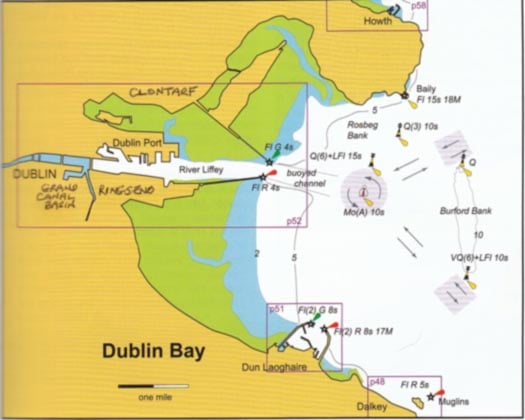
A busy little bit of water. Everyone wants a piece of the action on Dublin Bay. Plan courtesy Irish Cruising Club
You'd think that's all enough to be going along with, but bear with me. As far as administration of the built waterfront environment administration is concerned, we're only starting. King of the scene has to be Dublin Port, which really is the big beast in the administration arena. But snapping around its heels on both sides of the Liffey is Waterways Ireland, which has its canals north and south of the River. While WI may have allowed a reduction of the Spencer Dock going into the Royal Canal, across the river the sea-lock-accessed Grand Canal Basin on the south side has the potential to be the jewel in the Waterways Ireland crown, as it has a location to die for and the kind of industries which local authorities dream of – if California has its Silicon Valley, Grand Canal basin is Dublin's Silicon Harbour.
Despite the all-Ireland spread of its remit, Waterways Ireland is a smaller creature than Dublin Port, but you get an increasing sense of boundaries being claimed and defined as this once forgotten area of Dublin docklands comes rapidly alive. And of course another player in our list of statutory authorities which are very interested in the administration of the Dublin Bay area is the Docklands Development Authority, or whatever it's called now in the hope that we'll forget the debacle over the Irish Glass Bottle site.
So our chums in NAMA also have a decision-making role. And then, back in the water, the fact that the Liffey is a living river means that Inland Fisheries is another body than can be rightfully involved, as can organisations concerned with the well-being of those two important tributary rivers, the Dodder to the south and the Tolka to the north.
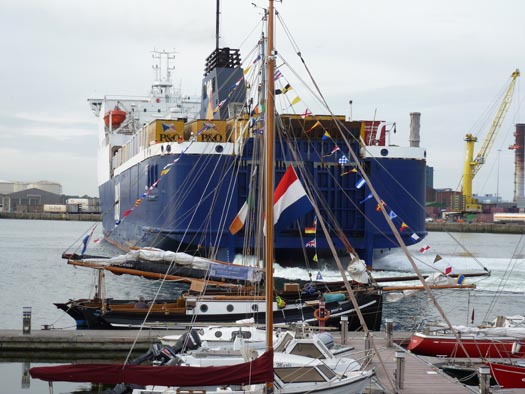
Sometimes it can seem too crowded for comfort. Ships and smaller craft share a narrow bit of water at Poolbeg. Photo: W M Nixon
All this complexity of administration in the Dublin Bay waterfront may seem convoluted enough already, but we haven't even got to Dun Laoghaire yet. There, the local council have put up the gross new library building as though to offend the other buildings on the established waterfront just as much as possible, while the Harbour Company is actively seeking ways of increasing its income – largely through accommodating cruise liners – as Dublin Port has been hoovering up the cross-channel car, passenger and ro-ro traffic through economies of scale.
Doubtless there are other statutory bodies which may be able to declare a legitimate interest in the running of Dublin Bay, but that's enough for now, so let's look instead at the consumer organisations. At a rough count, I can come up with twelve yacht, boat and sailing clubs, eight of which have premises. There are also at least six coastal rowing clubs, and five sea angling clubs. And there are several national boating bodies, all of which inevitably see a numbers concentration of their membership in the Dublin area, even if they conscientiously ensure that their administration reflects their nationwide nature.
If we really wanted to spread the net, we could come up with significant organization numbers for kite-surfers, windsurfers, canoeists and kayaks too. Plus there are two excellent links golf courses with their clubhouses right in the bay, on Bull Island. And finally, let's not forget Dublin Bay's own very special landmarks, the unused Smokestacks of Poolbeg. Boat users definitely want to keep them – at the very least, they tell us where we are. So we now have the ESB – or is it Electric Ireland these days? – central to a decision which is of great interest to Dublin Bay users.
By all means, let us know at Afloat.ie if you think there's a real need for some overall authority for the bay which can maintain the balance between sea and land, and between work, trade and recreation. It might seem like a good idea. But do we really need yet another level of bureaucracy? Yet another group of Jacks-in-Office who may even have staff with peaked caps and regulatory authorities which enable them to interfere with our natural freedoms?
It's a moot point, but I'll conclude with some experiences of how Dublin Bay is coming along as a genuine amenity for all, and look at some areas of developing interest. Of course, not everything in the garden is lovely. A public event which may have been a good idea on its first staging can become a bit jaded in its second year round, and this seemed to be the case with Dublin Port's Liffey Riverfest.
Last year, it had the attraction of novelty, and it included some Tall Ships, and also the major visit of the Old Gaffers Association international fleet in their Golden Jubilee Year. There was a busy shoreside carnival and many waterborne events including the Ballet of the Tugs and a race series for the historic Howth Seventeens. The restaurant Ship, the MV Cill Airne, provided an excellent administrative and hospitality centre, while downriver Poolbeg Yacht Boat Club's marina provided a very effective main base. It was all great fun.

The "Restaurant Boat" MV Cill Airne has proven very popular with visiting sailors in Dublin Port, but they'd like it even more if they could berth right at the ship. Photo: W M Nixon
So this year they extended the Riverfest to maybe five days in all, and for many who had been there in 2013, it seemed a bit jaded. They'd stepped up the shoreside entertainments, and noisy "fun for all the family" meant less fun for those afloat. The Howth 17s had dutifully turned up to put on a demonstration race or two, but this time round it seemed to be seen as no more than handy background moving maritime wallpaper. And as for the waterborne Ballet of the Tugs (now a daily occurrence throughout the Riverfest), those of our crew who had been there in 2013 said it wasn't nearly as good as last year, but one who hadn't been there in 2013 couldn't believe this - he thought it was absolutely marvelous seeing it for the first time.
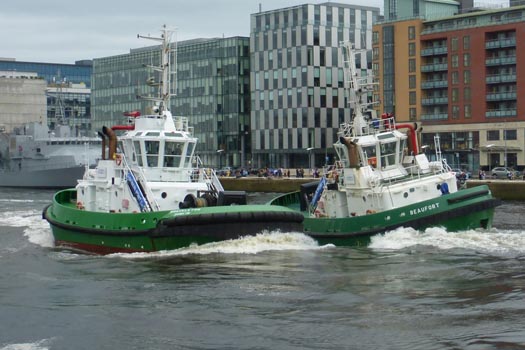
The Waterborne Ballet of the Dublin tugs Shackleton and Beaufort impresses those who haven't seen it before, but old Riverfest hands are always looking for something new. Photo: W M Nixon
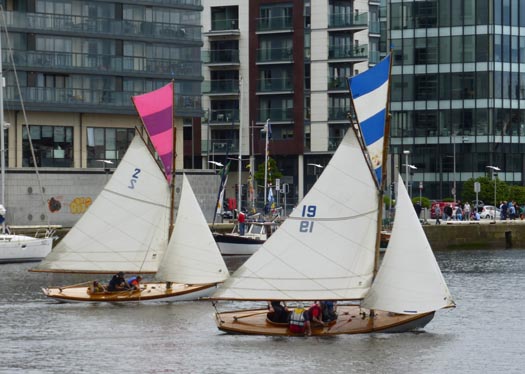
The Howth Seventeens do their duty with racing in the Liffey in the Riverfest, but for a fickle crowd on the quays always seeking fresh entertainment, the classic old boats are really just a form of moving wallpaper. Photo: W M Nixon
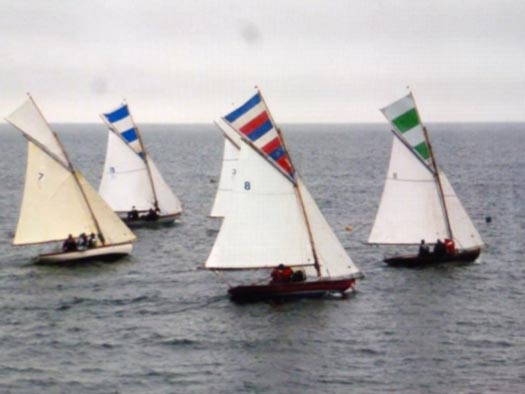
The Seventeens doing what they do best – getting in a bit of real racing. This is the leading group headed for the Clontarf At Home in July, and then on to Ringsend for Echo's Centenary Party at her birthplace. Although Echo (number 8) was the birthday girl, Deilginis (No 11) won the race to Clontarf.
Nevertheless, the old Howth Seventeens had done their duty by the Riverfest at the beginning of June knowing that later in the season, they'd have a weekend completely tailored to their own needs. The Lynch family's Howth Seventeen Echo was built in Ringsend in 1914, the only boat of the class to be built in that ancient maritime community of boatbuilders and sailmakers. So in July the class had their traditional race round the Baily to the Clontarf Yacht Boat Club At Home - an event which is totally tide dependent – then as the tide started to recede, the Seventeens got themselves round to hospitable Poolbeg.
There they were given a snug berth within the marina (most welcome as a giant cruise liner came up the river), then after a Centenary Party in PY & BC which is as near as boats can now get to Echo's birthplace in Ringsend, the party went up the quays to the Cill Airne for a dinner hosted by the Lynches, then after over-nighting at Poolbeg, on the Sunday they sailed home – mostly crewed by families – with a fair wind for Howth to round out a perfect couple of days.

The Howth Seventeens were very glad they'd been put in an inside berth at Poolbeg Marina in July after coming round from Clontarf, as the 113,000 ton cruise liner Ruby Princess was next up the river. Photo: Cillian Macken
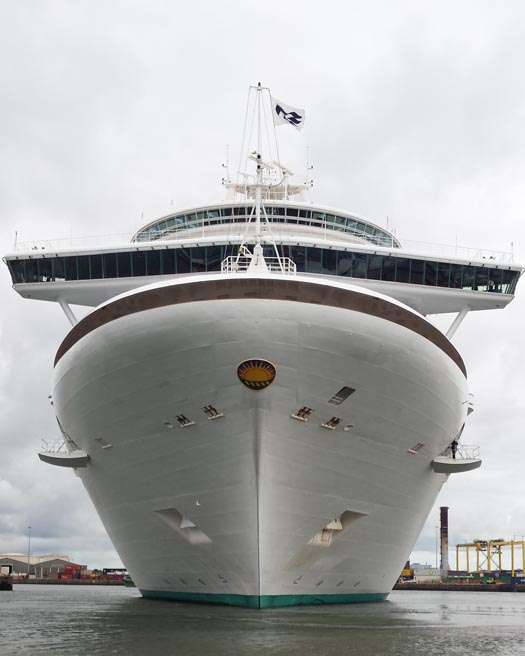
The Ruby Princess goes astern into her berth in Alexandra Basin with her bow only yards from boats in Poolbeg Marina. Photo: Cillian Macken
In other words, it was exactly the kind of weekend that most classic local one designs will enjoy hugely, but as entertainment for non-participants and spectators, it wouldn't have registered at all. This is the quandary which harbour authorities have to cope with in trying to give themselves a human face. You're either into boats and other waterborne vehicles, in which case almost anything to do with them is wonderfully entertaining. Or else you're not, in which case total incomprehension, and the ready seeking of almost any other kind of entertainment – and the noisier the better - is almost inevitable when you try to get general public interest and involvement.
Obviously the visit of a significant Tall Ships fleet is something whereby a port authority can combine both genuine maritime interest and public entertainment, but securing one is a major challenge. However, in Dublin port the new user-friendly attitudes have seen the extension of the pontoon beside the Point Depot just above the Eastlink Bridge, and while the rally of the Cruising Association of Ireland was a matter of the crews of around forty boats getting together and enjoying themselves rather than some high profile public entertainment happening, it certainly provided a useful insight into what boat visitors expect in a port.
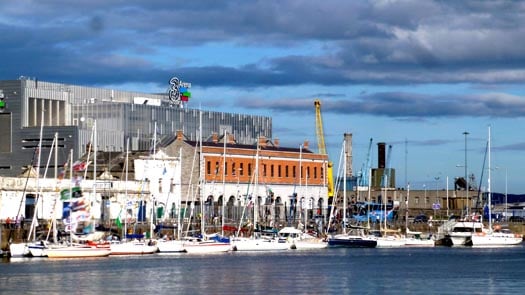
The Cruising Association of Ireland fleet was a fine sight at the new pontoon.......Photo: W M Nixon
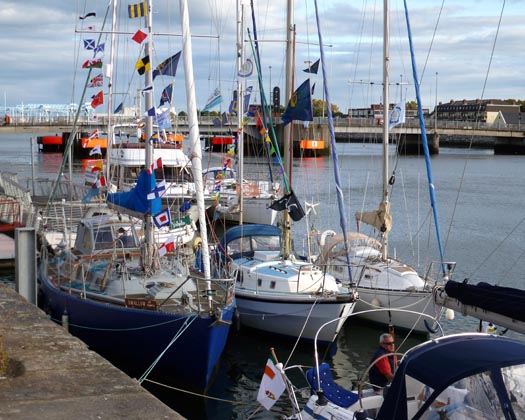
....but because of the need to keep the fairway through the Eastlink Bridge clear, they could only raft three deep. The blue boat in the foreground is Wally McGuirk's own-built 40ft steel Swallow, the last design by O'Brien Kennedy. Photo: W M Nixon
So I might as well start with the bad news. A forthright opinion came from the most experienced cruising man present. In a notably experienced group which included Wally McGuirk's very special own-built steel 40-footer, Swallow, the last boat to be designed by O'Brien Kennedy, being the most experienced is quite something. But whatever it means, it doesn't necessarily include diplomacy. When I asked this most experienced of all the cruising folk present what he thought of the new pontoons, he briskly replied: "They've put them in a stupid place. They should be up beside the Cill Airne, which is where everyone wants to be, and not down here beside the Eastlink Bridge with the likelihood of noisy crowds coming out of the Point Depot at a late hour, and the traffic on the bridge, which also means that we can only raft three deep in order to keep the channel under the bridge clear".
In fact, the CAI's end-of-season rally had a problem of success. Forty boats turned up to provide an impressive fleet but the most they could have at the pontoon, even with rafting, was thirty, so ten had to return through the bridge to Poolbeg where they'd been hospitably received the night before.
Once again, choosing the Cill Airne as the venue for the night's entertainment and meal proved a success, so ideally what's needed is berthing pontoons surrounding the ship herself. It would be mighty convenient, and also solve the inevitable security problems inherent in berthing in a city. But quite what shore-based hospitality establishments in the area would make of a ship in the river receiving such preferential treatment in the guiding of everyone's potential customers is another matter.

While the sea lock into the Grand Canal Basinon the south side of the Liffey went unoccupied the CAI fleet milled about to find berths on the North Quays. Photo: W M Nixon
However, across the river through a sea lock into the Grand Canal Basin, and you're into a snug and secure place that is surely a popular cruising destination that's just waiting to happen. Admittedly in Ireland people seem to have an aversion against having to transit a lock to enter port, but as they'll already have had to come through the Eastlink, having the lock ready can be part of the package. Within, you're totally secure, safe from big ships in the river and within easy reach of many facilities, including even the Daniel Liebeskind-designed Grand Canal Theatre.
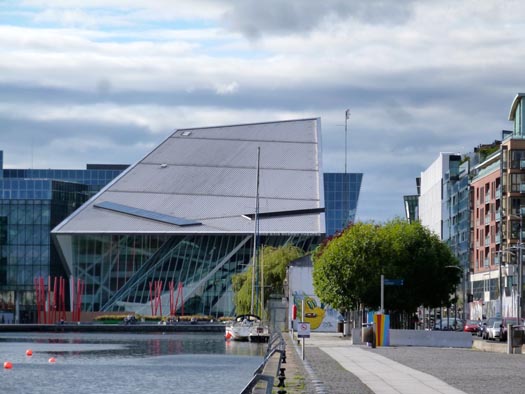
The total shelter of the Grand Canal Basin beside the Liebeskind-designed theatre. Photo: W M Nixon
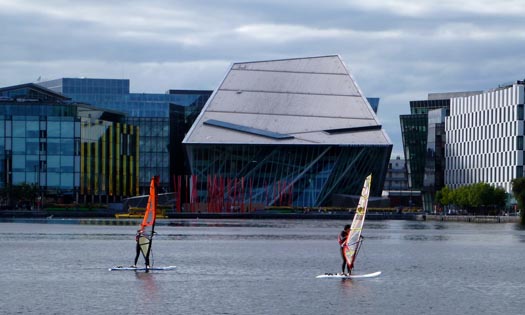
Even with other users such as trainee windsurfers and the Viking Splash ambhibian using the rad Canal Basin, there is still plenty of room for visitors. Photo: W M Nixon
Now that it has been sold to people of taste and discrimination, presumably we can hope that its clumsy current name of the Bord Gais Energy Theatre can be changed pronto. Admittedly there used to be a beloved little venue in Dun Laoghaire in the 1950s and '60s which was the Gas Company Theatre, and many a sailing person enjoyed an entertaining night of drama there. But times have moved on, and even public utilities have to be given more interesting and original names. Certainly when you have a situation where people unfamiliar with the First Official Language think that Ireland's newest and most glamorous place is known as the Bored Gosh! Energy Theatre, then something drastic yet creative has to be done.
Being in and around the Grand Canal Basin – which dates back to 1796 – really does give a sense of the past, even if many of the buildings are very new. But just across the River Dodder is Ringsend, and that is a place which is re-discovering its history as one of Ireland's most interesting maritime communities.
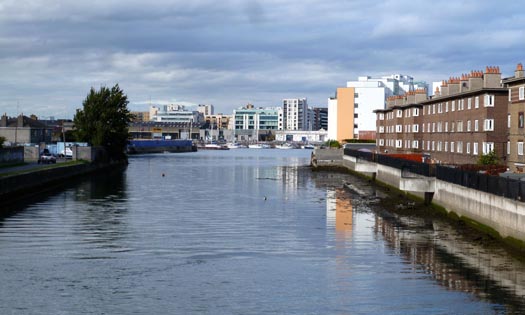
The view northward down the River Dodder from Ringsend Bridge towards the Point Depot on the other side of the Liffey. The entire riverbank on the right used to be a mix of boatyards and other marine businesses, but all that was swept away when the Thorncastle Street Dublin Corporation flats were built in 1954. Photo: W M Nixon
A packed house in Poolbeg Y & BC on Thursday night heard Cormac Lowth talk on the distinctive Ringsend sailing trawlers, and how they traced their development directly back to the arrival of Brixham trawlers from Devon, which were able to begin fishing the Irish Sea in 1818 a couple of years after the end of the Napoleonic Wars.
Brixham was a hive of fishing development and expansion at the time, and their fleets ranged the seas between Dublin Bay to the northwest and Ramsgate in Kent to the east. They originally were enticed to the facilities at the little Pigeon House harbour down along the South Wall, but soon crews were settling, such that nowadays in Ringsend there are still several prominent surnames which can be traced directly back to Devon.
With the Irish community established, there was much intermarriage, and the locals soon acquired the imported skills. Ringsend in those days was almost an island, and with its characterful fishing community, it attracted artists such as Matthew Kendrick and Alexander Wiliams, both of whom lived in Thorncastle Street, the main thoroughfare where the houses backed onto the River Dodder, along whose banks marine industries prospered.
Ship-building flourished, and one of the most talented families in this craft was the Murphy clan, who built on the banks of the Dodder (and then themselves fished) one of the mightiest cutters of them all, the 70ft St Patrick. But the demands of sailing such a boat with the standard crew of just three men and a boy were such that subsequent boats of both Brixham and Ringsend were ketch-rigged, and it's the ketch-rigged 70-footers such as Provident which we know as the classic Brixham trawler today.
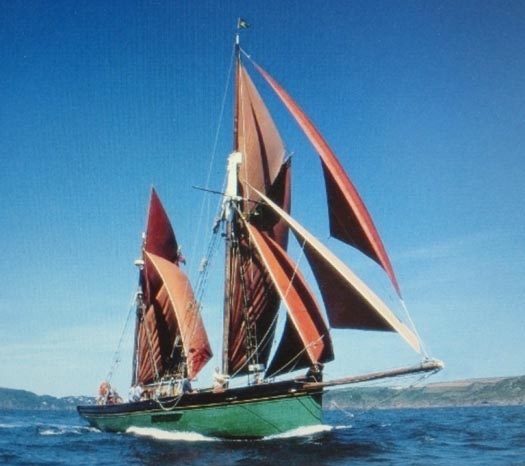
Provident, built in 1924, was one of the last and one of the best of the famous Brixham sailing trawlers.
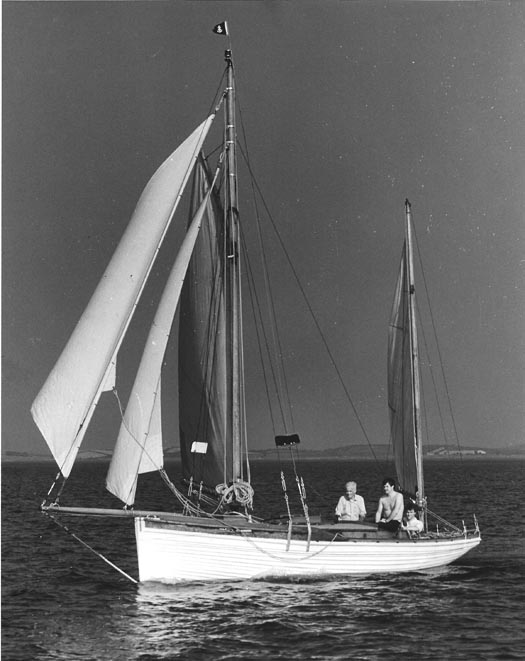
The 28ft Dolphin, built in 1924 in Ringsend, was a final acknowledgement of the hundred year old link to Brixham. She is seen here on Strangford Lough in the 1960s in Davy Steadman's ownership. Photo: Ann Clementston
Provident was built in Devon in 1924, by which time steam was already displacing sail as the preferred power system for trawlers. The effects of World War I from 1914-18 and the War of Independence in 1921 had further reduced the already much-weakened direct links between Brixham and Ringsend, but in 1924 the young designer-boatbuilder John B Kearney built Dolphin, a 28ft clinker-built gaff ketch, in Ringsend. Her design was a final salute to the Brixham connection, for in shape she was completely different from all Kearney's other yacht designs.
Dolphin has sailed through these columns before, but she deserves to be remembered again. And Cormac Lowth's wonderful lecture – it was utterly brilliant - brought the thought of her back to mind, for she's still around. So if anyone wants to make a small fortune, they first should first make a very large, indeed an enormous fortune, and then undertake the challenge of restoring Dolphin. She lies in a very sorry but still just about restorable state in a boatyard on Cork Harbour. Put her right with your large fortune, and you can be reasonably sure of having a small fortune at the end of it, but thre'll be a job which was well worth doing properly completed.

A very sad sight – Dolphin as she was in July 2014, at a boatyard on the shores of Cork Harbour. Photo: W M Nixon
Howth's Maritime & Sailing History is Brought Centre Stage
#hyc – A new billboard on Howth Yacht Club's prominent gable wall has re-kindled local and general interest in the Fingal port's place in Irish and international sailing and maritime history. And it has led to an upsurge of warm local pride around Howth Harbour. After a summer visiting other ports, W M Nixon returns home and tells how it all came about, and of the re-vitalised seaborn sport which has resulted from this imaginative initiative.
The world's most historically interesting and best-preserved one design keelboat class is hidden in plain sight just 14 kilometres from the heart of Dublin. And at the entrance to the harbour where these very significant boats have their secret summer existence, there stands the most perfect little classic lighthouse you ever saw. It too is hidden in full view.
Or at least, it all seems virtually invisible for many of the folk who live in Howth, who have simply become so accustomed to the presence of the 1817-built lighthouse and the 1898-founded Howth Seventeen Class that they scarcely appear to notice them any more. They seem to take them for granted, as is the case many of the other special features of what is a remarkably successful fishing and sailing port.
Well, maybe they do take a little bit of notice. Certainly if some environment-altering project gets under way which doesn't meet with quiet general approval, you'd be surprised by the level of opposition which can be aroused, and with effect too. But it's part of Howth's reserved way of doing and seeing things not to make a song and dance about local features of importance and attraction when they are as they should be. For it is a fact that, well within living memory, Howth most certainly didn't exude prosperity. So the ingrained pessimism of a fishing port means that when things are going well and the place is functioning as it should, you just stay quiet and don't make a song and dance about the good times rolling.
Nevertheless, now and again when someone with experience of the outside world, and the standing to have opinions which matter, says that Howth is very special and it's time somebody said so, we're quietly rather pleased. And when it's done in in a way which has the style and effect of the new Mercedes-Benz billboard on the prominent gable wall of Howth Yacht Club, we're very pleased indeed.
This billboard encapsulates much that it is significant in the history of Howth Harbour, and it gets the spirit of the place. It shows four boats of the Howth Seventeen class (the "17" refers to their waterline length) gliding in close formation under their full jackyard tops'l rig into the harbour past the gem of a lighthouse in a photo which is so pin sharp that you can easily read the date plate of 1817 on the lighthouse.

The Howth Seventeens which made it to stardom are (left to right) Hera (Michael Duffy0, Oona (Peter Courtney), Isobel (Brian & Conor Turvey) and Aura (Ian Malcolm) Photo of David Branigan photo by W M Nixon
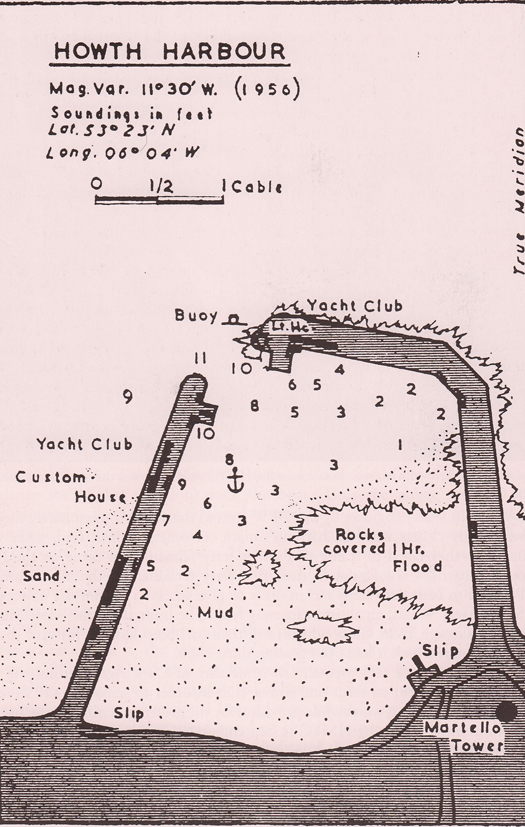
Howth was a distinctly disadvantaged port until relatively recently. Used as the main Dublin ferry port only between 1817 and 1826 (when Dun Laoghaire took over), it only became a "fishing station" around the 1840s-1850s. Then when the herring were fished out by the 1890s, some recreational boating space became available. But even by the late 1950s, as seen here, it was still a very limited harbour.
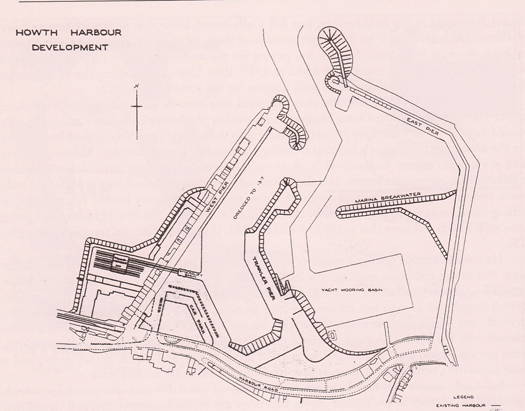
This outline plans for a major Howth redevelopment became available in the late 1970s. In those days, the very idea of a marina was anathema to some interests. So although a new breakwater is indicated as the "Marina Breakwater", the actual space in which Howth YC were to be obliged to install a marina at their own expense was only referred to as a "Yacht Mooring Basin".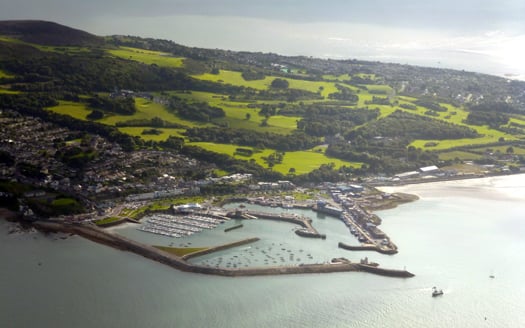
Howth Harbour as it is today, looking southwest across the peninsula with the waters of Dublin Bay at Sutton at top of photo. With clearcut boundaries between the different harbour uses, it has become a harmonious place. The presence of an active fishing port has led to a proliferation of good seafood restaurants. And the preservation of swinging moorings in the northeast corner of the harbour (foreground) has enabled the historic Howth 17s to survive and prosper. Photo: W M Nixon
The Howth Seventeens are part of Irish and international sailing lore. They still sail to the original design by Herbert Boyd of Howth House as signed off in October 1897, and they still race as keenly as they first did on May 4th 1898. More keenly, in fact - they currently have something like sixty races a year, and new boats and new owners and crews have lately been joining the fleet.
As to how they have acquired this overnight fame after 116 years, it's down to Stephen O'Flaherty of Mercedes-Benz. He brought together the needs of Howth YC for a sponsor for their Autumn League in concert with the fact that his quality marque sought a happy match with something which allied classic and timeless style, and could withstand the prolonged exposure of being on a highly visible billboard for the three years of the contract.
Working in close consultation with former and present HYC Commodores Derek Bothwell and Brian Turvey, the idea developed of a big screen photo which would encapsulate key aspects of Howth's unique maritime features in a clear and eloquent combination. Stephen O'Flaherty is owner of the achingly handsome Spirit 54 Soufriere, so he has an eye for a good-looking boat. And as a relative newcomer to being a Howth peninsula resident, he still sees it all afresh.
He pointed out that the little lighthouse at the end of the East Pier is still beautifully maintained, though it is now redundant as the working lighthouse is further north on the breakwater extension added in the early 1980s. Indeed, it is still even inhabited, and for many folk from elsewhere, that plucky little historic lighthouse symbolizes the spirit of Howth. It looks just as a lighthouse should, and it provides a perfect background for a sailing scene featuring the Howth 17s.
So all that was needed was a suitable day to get ace marine photographer David Branigan of Dun Laoghaire (who showed at last year's J/24 Worlds in Howth that he has a talent for drawing the locals' attention to the more picturesque aspects of their port and peninsula), line up half a dozen well-presented Howth Seventeens complete unto jackyard tops'ls, and get them in a harmonious arrangement with the lighthouse in the background and the flanks of the steep island of Ireland's Eye beyond, and lo and behold you have your magic picture, just like that.
Anyone who has ever tried to take a photo of just one boat sailing will realize what an extraordinary challenge this was, as even with one boat you're relying on the presence of a breeze, you're hoping for sunshine, and you're praying that when the best moment arrives, nobody will be standing up on deck or in the cockpit, or looking at the camera, thereby ruining the balance of the photo. And that's just with one boat.
Worse still, it all had to be brought together at very short notice. But the first day suggested for a photo shoot – Thursday August 28th and already under pressure with just two weeks and a couple of days to go to the start of the Autumn League – was a complete no-go with adverse conditions. Time was running out. It had to be Monday September 1st.
They had neither decent breeze nor sunshine on the day, and getting the Howth Seventeens to sail in concert is about as easy as herding cats. As for the wind, it was only fitful from the east, while to the inexperienced eye, the light seemed very flat, and no sunshine.
On top of that, team head Joanna Kavanagh of MSL had only been available on the Thursday – by Monday she was on another photo shoot in Portugal. But far from letting this get them down, the location team rose to the challenge. And the Howth Seventeen sailors gave of their best for a whole day. Show me a Howth Seventeen sailor, and I'll show you a ham......
In the cruel ways of Tinseltown, of the six Howth Seventeens which gave of their very best for that long and often frustrating day's shooting, two ended up on the cutting-room floor - Roddy Cooper's Leila and the Nick Massey syndicate's Deilginis. The final masterful Branigan photo shows Ian Malcolm's Aura (no 7) ahead of Peter Courtney's Oona (no 17), Conor and Brian Turvey's Isobel (no 19) and Michael Duffy's Hera (no 9).
As a sailing photo, it mightn't garner enough excitement to make it into a yachting magazine. But as a billboard designed to tell a story in a specific location, it tells ten thousand words, and tells them very well too. And as clearly as possible – Jason Hurley of Jason Hurley Designs, who was involved in the shoot, also cleaned up the raw photo afterwards to enhance it and take out stains from sails, scrapes from topsides, and weed from waterlines. When it went up just three days before the Autumn League was due to start on Saturday September 13th, it was to be greeted with a shared wave of enthusiasm of a kind which is rare enough in a quirky little community like Howth.
Needless to say, there were soon the usual quips to be heard. The Howth Seventeens survive through turning the laws of physics on their heads. Thus while energy creates friction for other folk, among Seventeen-footer persons it's friction which creates energy. There's nothing like a barbed remark or two to sharpen enthusiasm for the next race. So for those who have said that it takes a posed billboard photo to ensure that Ian Malcolm with Aura will be at the head of the fleet, let me say that in addition to winning races now and again, nobody else in the class has done as much to tell the world that the Howth Seventeens are alive and well and sailing more keenly than ever, and here's a selection of just some of the things that Aura has done in the last sixteen years:
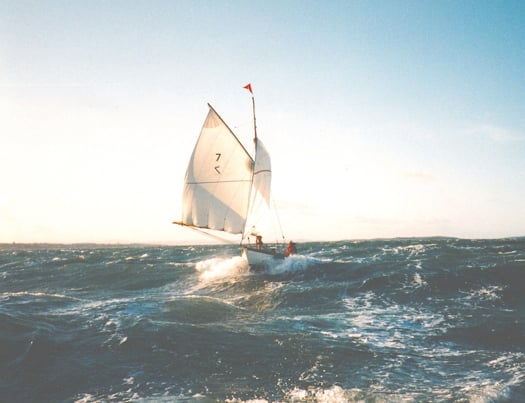
Aura goes offshore. In 1998, the Howth 17s celebrated the Centenary of their inaugural voyage from builder John Hilditch of Carrickfergus 95 miles non-stop back to Howth. Aura is seen here starting to get offshore off the County Down coast as a bright but very cold evening draws in on April 15th 1998. Photo: Damian Cronin
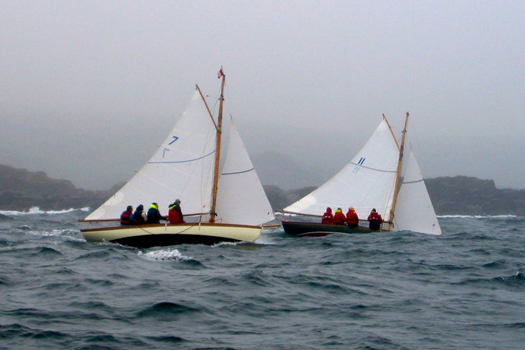 The Howth 17s make the scene at the Glandore Classics 2003 with a foggy race from Castlehaven to Glandore. Here, Aura is chasing Deilginis close inshore. The winner was the first boat to have a crewman downing a pint in Casey's bar in Glandore. Photo: W M Nixon
The Howth 17s make the scene at the Glandore Classics 2003 with a foggy race from Castlehaven to Glandore. Here, Aura is chasing Deilginis close inshore. The winner was the first boat to have a crewman downing a pint in Casey's bar in Glandore. Photo: W M Nixon

In 2008, Aura was the only Howth 17 to take part in the Waterways Ireland Classic Boat Regatta at Dromineer on Lough Derg. She is seen here sharing the lake with an International 12, Water Wags, Shannon One Designs and a Folkboat together with the 1873-built committee boat Phoenix (John & Sandra Lefroy). It was the first time a jackyard tops'l had been seen on Lough Derg since before the Great War of 1914-18, as the post-war fleet there were either gunter or Bermuda rigged. Photo: Gerardine Wisdom

Aura and Deilginis off the Royal Yacht Squadron Castle at Cowes in July 2013 during the Classic One Designs Regatta. It is thought to be the first time the Howth 17s were in the Solent. Photo: Mel Massey
As to the Howth Autumn league, it started 35 years ago in a low key sort of way, when the boats of the newly-formed Squib Class realized they'd been at full first season fleet numbers for only a few weeks, yet if they followed the local wooden-boat traditions, they'd soon be laying up. But the Squib is a minimal maintenance little 19ft keelboat, most of the boats were new in any case, and the Lasers had been having their annual winter series in Howth since October 1974. So the Squibs decided to tag themselves on to the Laser race officer team, and continue their sailing until early December, and thus was the Howth Autumn League born, though it didn't become a fully-fledged all-keelboat-classes business until the marina opened in 1982.
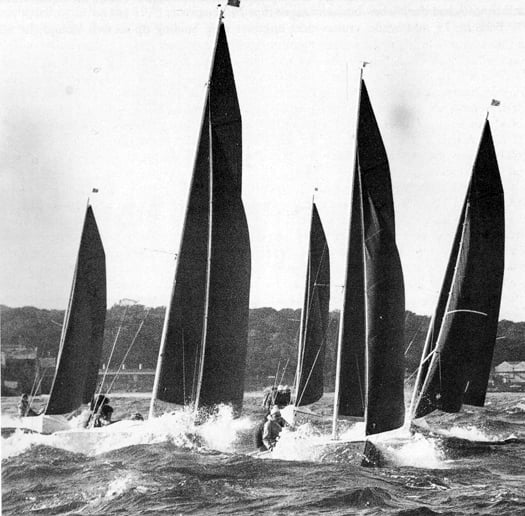 When it all started. The newly-established Squib Class inaugurated the Howth Autumn League in 1979, and this was the first race of that series. Photo: Jamie Blandford
When it all started. The newly-established Squib Class inaugurated the Howth Autumn League in 1979, and this was the first race of that series. Photo: Jamie Blandford
Underlying all this, the Howth Winter Lasers will be celebrating their 40th Anniversary. And it also means that HYC have had a continuous sailing programme since their Opening Day in April 1974. But last weekend the first race of the Mercedes-Benz Autumn League 2014 was enough to be going on with, sailed to mark the new sponsorship and the 35th anniversary of the inaugural Autumn League. And as I was one of those mad keen little Squib skippers 35 years ago, it was an ideal opportunity to take up an invitation to race on Soufriere and mark it all with a bit of style.
She has been having a good year on the race courses. Stephen O'Flaherty has teamed up with David Cagney to bring that wayward sailing genius into his regular crew, and while you wouldn't dream of calling them the Odd Couple, the phrase springs irresistibly to mind. They have raised Soufriere's racing to a new level, with an excellent win in the long inshore race at the Panerai Classics at Cowes in July, and then last month they found a new level of joint success with an extremely good debut in Two-Handed racing in the Aqua Double-Hander at Howth, leading a fleet of 34 boats on the water and on corrected time for much of the race round Lambay and the Kish and back to Howth Harbour, only slipping to a close second overall through being becalmed for a couple of minutes just yards short of the finish line.
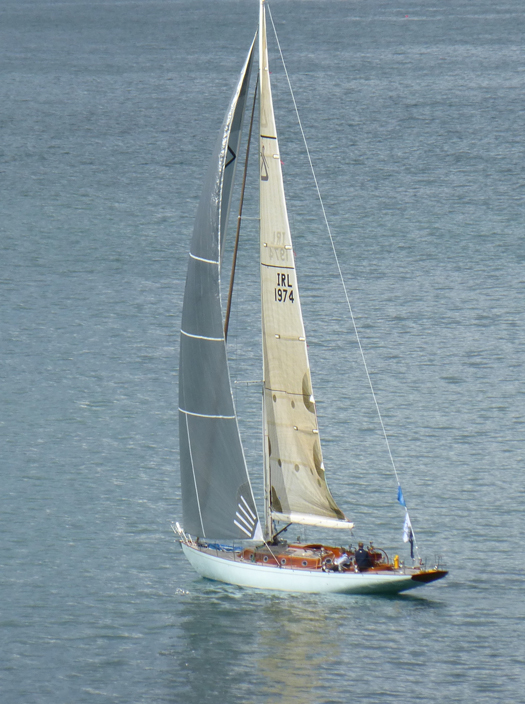 Soufriere approaching the finish of the Aqua Double-Hander at Howth in August, when she would have won overall on both handicaps had she not been becalmed for four minutes within yards of the line. That race-winning headsail may look gossamer light, but on a 54-footer it weighs around 40 kilos, and it's quite a haul for a two man crew to get it aloft. Photo: W M Nixon
Soufriere approaching the finish of the Aqua Double-Hander at Howth in August, when she would have won overall on both handicaps had she not been becalmed for four minutes within yards of the line. That race-winning headsail may look gossamer light, but on a 54-footer it weighs around 40 kilos, and it's quite a haul for a two man crew to get it aloft. Photo: W M Nixon

A penny for your thoughts....David Cagney and Stephen O'Flaherty pondering the options for Soufriere when their just isn't enough wind to get the big lady moving properly. Photo: W M Nixon
Many folk would think it absurd to race a "new classic" like Soufriere against the likes of our opposition last Saturday, as it included Nobby Reilly and Alan Chambers' Mills 36 Crazy Horse, and the Kelly team's J/109 Storm which is always there or thereabouts in ICRA Racing, and has been ICRA Boat of the Year in her time. But Soufriere has a modern underwater profile of vertical bulb keel and spade rudder, and despite her very attractive wood construction in edge-glued strip planking, her all-up weight is only about nine tons.
Nevertheless, she does have to cart about these elegant long ends, which are only an asset for extra speed when the wind is above a certain strength. To add to the challenge, the ideal minimum wind varies, dependent on which point of sailing you're on. Beating, she seems to come to life in as little as 6 knots real wind speed. Reaching, you need about 8 knots. But downwind, she's sticky until it's getting near 10 knots, and preferably more.
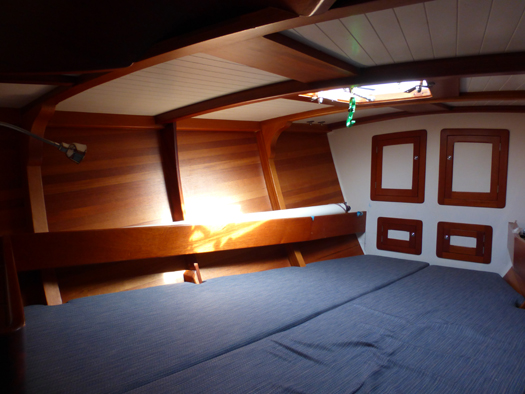
The forward cabin shows the Spirit style. With the wooden hull unlined, the noise of the water going past is pleasantly distinctive. Photo: W M Nixon
As to the impression on going on board, you have to think of Soufriere as they do with the Howth Seventeens, in terms of her waterline length. She certainly doesn't have anything like the accommodation of a standard modern 54 footer, and even her waterline length of 12m (39ft 8ins) suggests more room than there is, as her beam is only 3.3m (10ft 10ins). But within that, the accommodation is welcoming and elegant, and the boat gives out very pleasant vibes, as she is immaculately maintained by Tim Foley of Dun Laoghaire.
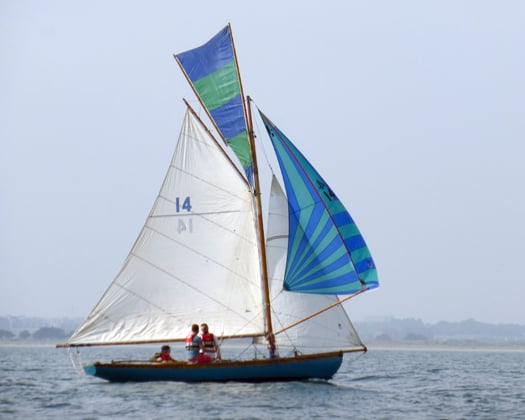
Back in harness. Aidan MacManus of the King Sitric Restaurant has re-joined the Howth 17s by buying the Howth 17 Gladys in partnership with Kieran jameson and others. He first bought Gladys in 1974, and is the first helmsman to have won a race in the Seventeens with 16 other boats astern. Photo: W M Nixon
Going out for the that first race of the re-vitalised Autumn League last Saturday, we motored quietly along past noted restaurateur Aidan MacManus in his Howth 17 Gladys, which he has re-bought in partnership with Kieran Jameson and others. Aidan first bought Gladys in 1974, and he is written permanently into the class's history as in 1988 he was the first skipper ever to win a Howth 17 race with 16 other boats behind, for in a class of such great age, it's seldom that any season will see all the boats afloat.
The wind was light easterly on a day which belied it was mid-September, shirt sleeves stuff and careful reading of summery conditions which were too light for Soufriere. But the team gave it their best shot, and when there was occasionally that essential little bite to the breeze, suddenly we were at the races.
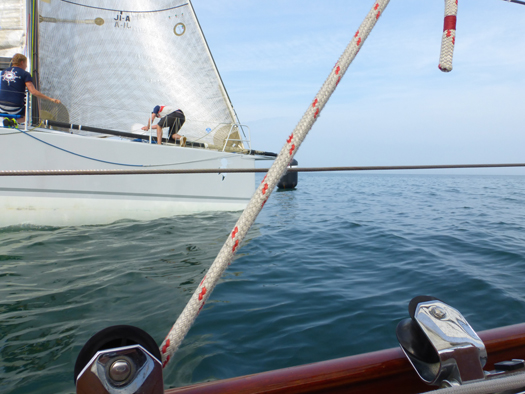
Reaching the weather mark neck-and-neck with Crazy Horse but miraculous to tell.......... Photo: W M Nixon
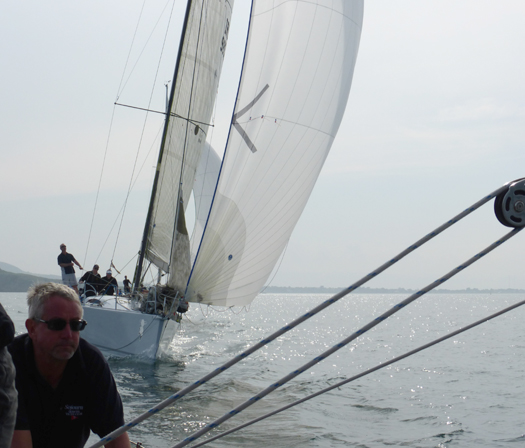
....on the reach Soufriere found her groove and the Horse was soon put astern......Photo: W M Nixon

.....and for as long as we were on the reach, we were lengthening away......Photo: W M Nixon

.....while the crew prepared for the run. Photo: W M Nixon
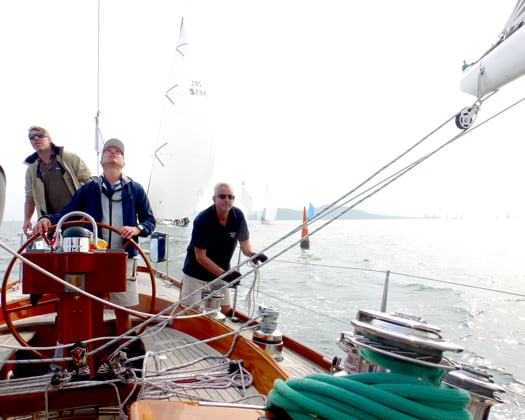
Deflation. We pass the mark at the end of the reach, knowing the run can only mean one thing.......Photo: W M Nixon
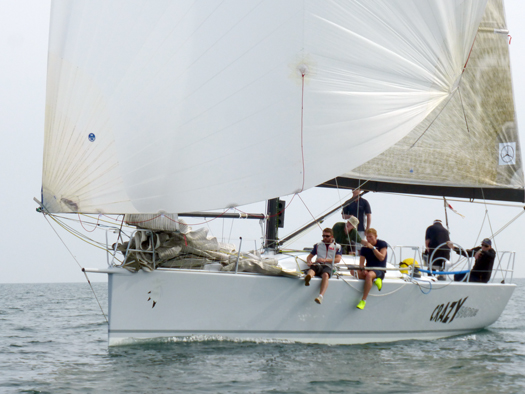
....and with her spinnaker pole deployed, Crazy Horse was soon rolling over us, so we gybed away into what proved to be the light wind side of the leg. Photo: W M Nixon
We rounded the first weather mark vying for the lead on the water with Crazy Horse, and then - mirabile dictu – Soufriere found her mojo and rolled over the Reilly-Chambers boat and led down the short reach to the next turn, but after that it was a wearing dead run with light patches everywhere. Crazy Horse was soon over us again, and as we don't carry a spinnaker pole, we were tacking sharply to lee down the left hand of the run where winds became lighter, while the Horse and Storm went to the right to find a better breeze, and both were ahead at the lee mark.
But then they clearly reckoned they'd used up all the breeze over to the northeast during their success on the run, so for the beat they went to the right where we'd been flat on the run. We meanwhile were left all on our own to do what we wanted, taking a big punt to the left, and it paid in spades. Getting back up to the weather mark, Storm was well astern and we were snapping at Crazy Horse's heels.

On the second long run, we managed to keep in contact with Crazy Horse.....Photo: W M Nixon

.....while Storm took the scenic route, seeking a private breeze in under the cliffs of Ireland's Eye. Photo: W M Nixon
The next run piled on the pain, but somehow we were hanging in with Crazy Horse, and Storm took a flyer right in under the cliffs of Ireland's Eye. With the wind fading, the Committee Boat had gone over towards Malahide to shorten the course at the lee mark, and a fine selection of the 97 boat fleet were running down together towards it from their various courses.
It made for a very civilised finish time instead of hanging around far into the evening, and we might have hoped for a third or even a second as the long lady which is Soufriere had been doing her very best. But then, just as we neared the finish, didn't the breeze pipe up for a crucial quarter of an hour. We finished at a crisp little speed, but down towards Ireland's Eye the two J/109s and the X332 Equinox were coming up towards the finish with bones in their teeth, and a reasonable chance of a third or even a second for us evaporated to fifth, suddenly three minutes down on the fourth-placed J/109 Dear Prudence (Patrick Cruise O'Brien), while the other J/109 Storm had finished at such speed she pipped Crazy Horse for the win.

At last a bite to the breeze, but we're just about to finish.......Photo: W M Nixon
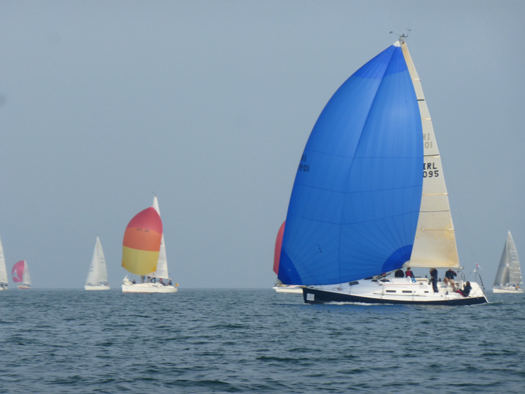
.....so the brief but temporary breeze at the finish brings up the tail-ender Dear Prudence with a bone in her teeth, and Soufriere is pushed back into fifth on CT. Photo: W M Nixon
But that's boat racing. It had been an interesting day in good company, and when she could, the lovely Soufriere rewarded us with competitive performance, at all times with the water tinkling past in that special way it does with a wooden hull. She was a joy to be aboard.
On the 35th Anniversary of the introduction of the Howth Autumn League, it was good to be heading back in the hazy evening sun into this regenerated port where modern facilities are right beside the traditional anchorage. There, the eternally re-born Howth 17s were striking their tops'ls after an afternoon's racing, just as they've always done for 116 years, while continuing with the banter which will go on for ever.
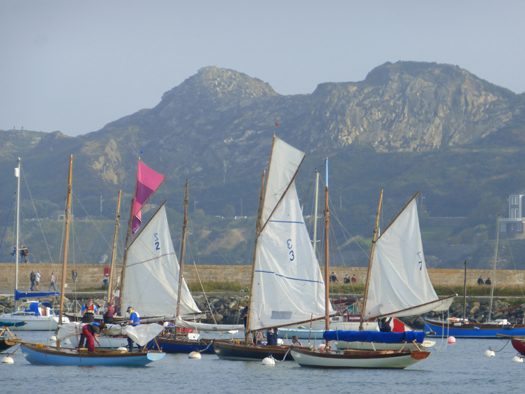
The Howth 17s striking their tops'ls after a Saturday afternoon race, as they have been doing for 116 years. Photo: W M Nixon

A very likeable boat, and remarkably rewarding to race against more modern types. Soufriere in her berth at Howth after the first race of the MSL Autumn League 2014 at Howth, showing the quality of the work Jimmy Foley of Dun Laoghaire puts into her maintenance. Photo: W M Nixon
#strangfordlough – It's most encouraging to see such interest in the magic of Strangford Lough writes W M Nixon and if we missed out on some aspects of it in reviewing our time there (see blog and comments here), it was only because we had already so much material on the agenda of primarily dealing with the Rivers and the GP 14s.
I take Theo Rye's point that the Linton Hope-designed Dabchicks of 1895 were probably the world's earliest one design class with Bermudan rig, but would plead that I think I meant to describe the Rivers as the world's first one design keelboat class with Bermudan rig (well, he would say that, wouldn't he?).
As for William Jenkins pointing out that Glens were also racing that night of Wednesday August 13th, so too in a combined class were the RS Elites and Flying Fifteens. The Glens, like the Rivers, had good racing, but here too one boat was dominant, Glenlark sailed by Richard Aitken whose family have owned the boat from new, his crew including Irish Cruising Club Vice Commodore Alan Leonard.
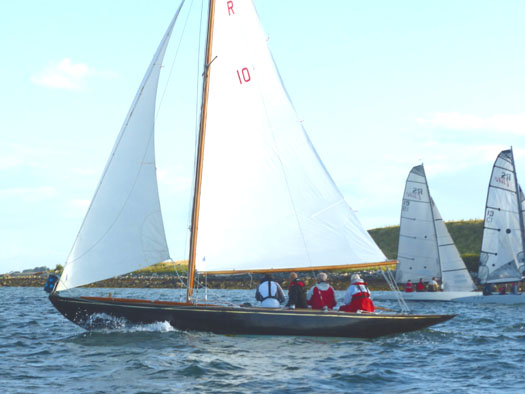
Two RS Elites shaping up for their start (right) closely watched for pointers for their own start by the crew of Brian Law's River class Uladh (foreground). Photo: W M Nixon

The SLYC Glen Class racing with Richard Aitken's Glenlark (right) well positioned on the favoured west side during the beat. Photo: W M Nixon
The Strangford Lough Glens are on something of a roll these days, as this past weekend (August 16th & 17th) they had their annual team racing series against the Dun Laoghaire Glens, and though it was an away match for the Whiterock squad which was captained by SLYC Commodore Ian Gleadhill, they won overall in a series which was curtailed by Sunday's foul weather.
As for the quality of the courses and the race management at Whiterock on the night of Wednesday 13th August, the photos speak for themselves. Racing started in a brisk and sunlit nor'wester, the course provided two excellent long beats and lots of spinnaker work, and it was all neatly wrapped up after sunset but with every boat finishing the course despite the dying breeze and gathering darkness. It was club evening racing at its very best, and the banter at the tasty post-race supper in the clubhouse rounded out an excellent programme.
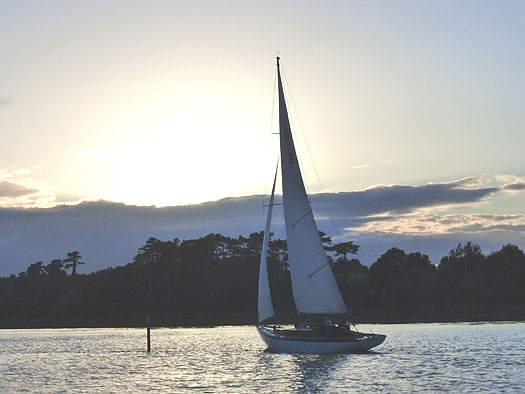
Evening racing timed to perfection. In the long-drawn-out northern sunset, Richard Aitken's Glenlark arrives in the lead at the weather mark. SLYC uses simple but clever ballasted plastic piping racemarks, and even when the tide is across them a displacement boat will find she has a very forgiving cushion of water between mark and boat when trying to shoot the turn. Photo: W M Nixon
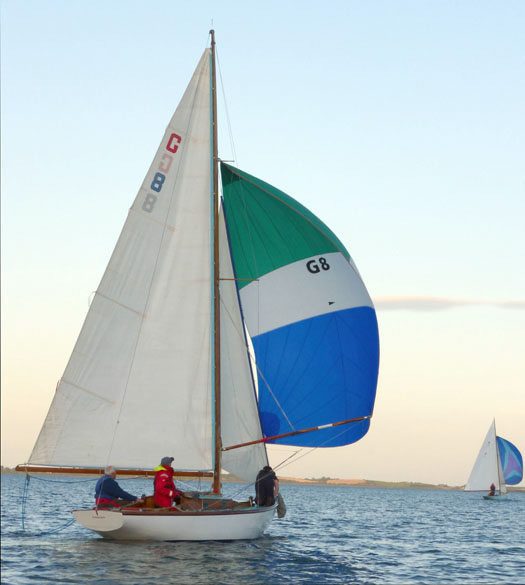
The last of the sunshine plays on the fields of the Ards Peninsula to the east as Glenlark consolidates her lead down the final run. Richard Aitken had read the beats so well he was up among the tail-end River Class boats. Photo: W M Nixon
If you've ever team-raced for "The Book" between Sutton Dinghy Club and a team from Cork Harbour, then you'll know that it is Irish sailing's Book of Kells, inaugurated seventy years ago with the winning team obliged to inscribe the outcome on vellum in illuminated style. W M Nixon found that this year's event last Sunday had the Corkmen celebrating a win, even if they lost the race.
Keeping the records of sporting events may seem the simplest thing in the world, but it's amazing how quickly the written reports can disappear completely. In this blog on 12th April, we were pointing out that ancient sailing trophies are doubly valuable, as they'll still be in existence and lovingly cared for because of their intrinsic worth as pieces of silverware, and with any luck they'll also carry the name of the boats and owners, the early winners of races back in those remote mists of time.
Yet even the world's oldest original sailing trophy, the Ladies Cup of Sligo Yacht Club which dates back to 1822, took a while to cop on to the need to inscribe the names. It didn't occur until 1831, when the winner was Owen Wynne of Hazelwood on Lough Gill, that lovely lake where the Sligomen sailed before they took to the sea at Rosses Point.
Because of this understandable omission – after all, everyone who was anyone in Sligo in the 1820s would have known know who was the current holder of the Ladies Cup – the oldest sailing trophy with a winner inscribed wasn't an annual challenge cup, it was a one off, the Cork Harbour Regatta Cup for 1829. The winner was J Caulfield Beamish with his cutter Little Paddy, which he designed himself. It's a thoughtful experience to contemplate this old trophy, and realize it was once handled by one of the greatest if largely unsung pioneers of Irish sailing.
But beyond the fact of who won, we know little enough of the event in 1829. And as sailing developed down the years, a plethora of events meant that the records became confused, or else there was so much data that nobody took any notice any more.
Enter the International 12ft dinghy, a simple little lugsail rigged clinker-built classic wooden boat. She was designed by George Cockshott of Southport in Lancashire in 1912, and seems to have been an instant success with the approval of the Boat Racing Association, a sort of precursor of ISAF. Fleets sprung up anywhere that sailing took place, though the class soon faded in England where newer designs appeared in the 1920s and '30s. But today, there are thriving groups of International 12s in The Netherlands, Belgium, Italy and Japan, while in Ireland they were quite the thing until 1950.
One good reason for this was that Ireland produced an International 12 superstar, Captain Jimmy Payne of Cork Harbour, who won the World Dinghy Championship racing International 12s in Belgium in 1924, the first time the new Irish Free State had competed in a sailing event in its own right. This meant that the return series for the crews from France, Holland, England, Belgium and Italy came to race against Ireland at the Royal Munster YC in Crosshaven in 1925. This time round it went down to the last race, which Jimmy Payne won by 29 seconds from Bokre of Holland, and his prize was a truly magnificent silver model of an International 12.
The International 12s were also popular around Dublin, particularly on the north side of the Bay where they either sailed from Howth or, when the tide suited, at Sutton Creek. There was only one club on the peninsula at the time, Howth SC, which sent forth an International 12 helmed by Harry McCracken to sail in the Tailteann Games in 1932, and he won the gold medal.
With International 12 sailors of this calibre in both Cork Harbour and around the Howth peninsula, there were links between the two class centres. But it wasn't until 1940 that Sutton Dinghy Club came into being beside the tidal creek. Then in 1944 an inter-club competition was inaugurated in International 12s between SDC and the Cork Harbour Sailing Club, whose young dinghy-oriented sailors with their International 12s included several people who were later to be big achievers in major clubs.
The innovative trophy for the new series was a large vellum book, the pages blank and awaiting inscription. There may well be other inter-club sailing club competitions whose perpetual trophy is an inscribed book containing the record of each annual race, but we don't know of them. Yet the continuing existence of The Book has been so central to a golden thread of sailing in Crosshaven and Sutton that those who have been involved tend to assume that everyone else knows all about it.
The Book (senior version from 1944) and the junior (from 1980) on display at Sutton Dinghy Club for Sunday's 70th Anniversary series. Photo: W M Nixon
Perhaps they do, but this year being the 70th Anniversary, it went slightly more public anyway, with Commodore Andy Johnston and his members at Sutton DC moving mountains to make it happen in a busy season in which, every other year, the race for The Book has to be slotted into a crowded annual programme and the additional need to fit the tidal window for sailing in Sutton Creek.
Over the years, The Book has stayed the same, and it's still the same Sutton Dinghy Club, albeit in larger premises. But Cork Harbour Sailing Club – whose members had been helped in their sailing by Jimmy Payne himself, who also raced for The Book – was wound up in 1950, and its membership largely subsumed into the Royal Munster in Crosshaven, which in turn became the Royal Cork for the Quarter Millennium in 1970.
Over the years, Irish sailing classes which have seen people emerge from the testing and training ground which is the racing for 'The Book' include Olympic boats such as the Flying Dutchman and the Tempest, the famous 505s, many offshore racing fleets, Fireballs, 470s, Lasers, 1720s, SB20s, Etchells 22s, Puppeteer 22s and J/24s, to name only a few. In all, it's an extraordinary list, linked by their connection to sailors from this unique event.
The historic International 12 restored by Aidan Henry of Sutton. Photo: W M Nixon
For many years, The Book was raced for in IDRA 14s, and this restored gem shows off her elegant lines at Sutton. Photo: W M Nixon
As for the gallant little International 12s, they were shunted aside in favour of IDRA14s in 1950. But there was a sweet reminder of the little boats at the 70th anniversary event on Sunday with a beautifully restored version brought back to life by Aidan Henry of Sutton, while also there was a lovingly-maintained and historic IDRA 14. Over the years, classes used have further changed, and for a while all the Cork-based races for The Book were sailed in Enterprises, while a Junior Book inaugurated in 1980 tended to favour Mirrors.
Boats may change and people move on, but The Book has remained as an extraordinary record of personal history and sailing development. The first series in 1944 was well won by Sutton, but over the years the balance has tilted in Cork's favour with 26 wins to Sutton's 18, while there have been two draws and 23 no races resulting from some weekends of total gale and other more grisly reasons - in 1956, it was the polio epidemic.
Grim reminder of times past – the terse entry in The Book for 1956 Photo: Ron Maher
Of that first Cork team of 1944, happily the great Joe Fitzgerald is still with us, and he subsequently sailed on winning teams. As you work your way through the handsome big pages, the names cascade down the years, so much so that just about every sailor of significance from Cork Harbour or Sutton (and sometimes Dublin Bay generally) has been racing for The Book.
The teams and Race Officers at Sutton in 1944 – Joe Fitzgerald of Cork is third from the right in the front row.
Royal Cork won in 1966 with a stellar team
Sutton's Ian Sargent and Royal Cork captain Harold Cudmore with The Book and their teams in 1966
These days, the Sutton sailors favour GP 14s, while for many years now the National 18s have been the heart and soul of Crosshaven sailing. This is so much the case that last year the Crosshaven class produced a fine book by Brian Wolfe not just of its history in Cork Harbour since 1939, but about the story of the National 18 at all its class centres through England, Wales, Scotland, Ireland and the Isle of Man.
Both the GP 14s at Sutton and the National 18s at Crosshaven are having a busy season throughout 2014. But it was noticed that while the cream of the Crosshaven class would be at the British & Irish National 18 Championship in Abersoch in North Wales from July 28th to August 1st, the top GP 14s at Sutton would not be heading away for their Worlds at East Down YC on Strangford Lough until Friday August 8th. There was a tiny window of opportunity on Bank Holiday Sunday, August 3rd, when the paths might be made to cross and the tide suited in late afternoon. So they grabbed it, and Sutton Dinghy Club readied up six evenly-matched GP 14s in a very focused frame of mind, as they hadn't won The Book in sixteen years.
These National 18 sailors from Crosshaven certainly are keen. Despite having raced a gruelling week in Abersoch with the National 18s, Tom Crosbie, Barry O'Meara and Tom Dwyer were ready and willing to race GP 14s for The Book just a day later. Photo: W M Nixon
The two teams for the 70th Anniversary of racing for The Book – Tom Crosbie (left) is Cork captain, while Hugh Gill (centre) captained Sutton. Photo: Ron Maher
At first, conditions looked reasonably promising, but fast moving clouds south and north.............Photo: Andy Johnston
....gave every indication of stronger winds to come. Photo: Andy Johnston
Downsizing from an 18-footer to a 14-footer was gallantly accepted by Cork crew Tom Dwyer and Barry O'Meara. Photo: Andy Johnston
After a week of hard racing off Abersoch, the Corkmen could have been forgiven for wishing only to head on home for a rest, but they're great sportsmen, they were determined to give it their best shot. However, for people down-sizing from a three man 18 footer to a two man 14 footer just for one afternoon's team racing, the conditions were cruel, with a squally west to southwest wind, and a fast-changing sky which promised more to come.
It duly delivered. They managed the first race with the teams even at first, but then Hugh Gill of Sutton sailed Patrick Crosbie of Crosshaven away from his lead over the next Sutton boat, and that changed the table just enough to have Sutton ahead by one point after one race. And that was the end of it. The wind rose well up into the 30 knot zone, there were four capsizes and one dismasting, and The Book for its 70th Anniversary went to Sutton Dinghy Club after a gap of sixteen years.
Tom Crosbie (left) returns The Book to Sutton's Hugh Gill after a 16-year run. But next year's racing will be in Cork in National 18s......Photo: Ron Maher
Yet everyone was delighted with the day. While the team racing tactics may have been cut-throat, the sport was great, and you could have run a string of bright lights off the camaraderie, with Dommo Long, the father of the National 18s, still much involved, although it's a report in The Book from very long ago which records how he kept all Sutton entranced with the post race party until six o'clock in the morning.
The National 18s as they are today. Photo: Bob Bateman
Testing the water. Father of the Class Dommo Long has an approving trial sail on the new National 18 last Autumn. Photo: Bob Bateman
Next year, of course, it will be an away match for the Sutton crews. And who knows, but they may be able to race in the brand new National 18s, a Cork-inspired concept which has been coming along very nicely, and is set to become Ireland's hottest "new" class in 2015, which goes some way to explain why the Cork men arrived in Sutton in such good form.
We ran a story in Afloat.ie about the Phil Morrison-designed prototype sailing at Crosshaven last Autumn, the boat having been cleverly developed through outside sponsorship so the €65,000 development cost didn't make a dent in the class funds. But a prototype is one thing, getting it accepted by the class association and into production is something else altogether, and everything would hinge on how the mood went at the championship in Abersoch, which would also see the crucial AGM.
Afloat, everything went fine for the Corkmen. Stuart Urquhart of the Scottish fleet may have had a good lead in the early stages, but by the finish the 2014 Champion was Ewen Barry of Cork crewed by Dion Barrett and Stan Browne. In runner up place was another Cork helm, Colin Chapman (who has played a leading role in the moves towards the new design), crewed by Bobby Bearla and Morgan O'Sullivan, while initial leader Urquhart was back in third.
The new Odyssey National 18 looks the business for speed..... Photo: Bob Bateman
......and she retains the basic seamanlike features of the established National 18s. Photo: Bob Bateman
The new boat Odyssey was out sailing and showing fabulous performance, so minds were concentrated mightily for the main formal business which came on Thursday July 31st, the 2014 AGM and the acceptance or otherwise of the new design. The National 18 is a restricted class, so in theory any new design which complies with the rules should be accepted. But the days are long gone when cheque-book sailing affected the class – if it ever did – so a significant majority would be needed to be in line with the spirit of the class, which has always favoured design development, but at a measured pace.
The vote was better than a significant majority – it was overwhelmingly in favour. Exciting times lie ahead, and no more so than in Cork. Twelve deposits have already been put down on new boats to the Odyssey design, and eight of those have come from the Cork Harbour fleet.
There's no doubt the new Morrison boat is a gorgeous bit of kit which is a delight to sail, and if you doubt this, I've been told to say that Dommo Long says so. Already, the class is rejuvenating around Cork Harbour, and though there are bound to be growing pains, you need to experience the sheer joy in sailing and the camaraderie of a handsome big three-man boat to understand the extraordinary sense of community which the National 18s engender in the special RCYC context.
In the final analysis, these people are sportsmen who sail for fun, and their dedication and enthusiasm is a joy to behold. They're respectful of the past, yet excited about the future. And the spirit of Jimmy Payne and the International 12s lives on, not least in the fact that the supreme overall prize for the National 18s in Cork Harbour is now the silver International 12 trophy which he won back in 1925.
In 2011, Mrs Eithne Payne presented the International 12 trophy, won by her father-in-law Captain Jimmy Payne in 1925, to RCYC Admiral Peter Deasy to become the season-long overall winner prize for the National 18 Class on Cork Harbour. Photo: Bob Bateman
Facing Up To Irish Sailing's New Realities
#irishsailing – Ireland is having a busy sailing season through 2014, but there is concern about the decline in turnouts in some major events. W M Nixon suggests that, during the years we've been pre-occupied with weathering the economic storm, we may have missed the fact that the basic structure of sailing is changing.
We've lived through interesting times, these past few years. And with Ireland's particular woes during the global financial crisis, the general lack of money and resources, coupled with the decline in simple enthusiasm for living energetically and enjoying participant sport, has obscured the fact that sailing – like most sports – has been changing, with an increasing emphasis on focussing attention on a few big professional events, rather than celebrating the small and the local.
A clear case in point was the visit of the Clipper Race to Derry/Londonderry, which coincided precisely with the weekend at the end of June when the biennial Round Ireland Race was staged from Wicklow. Although there were many entries racing round Ireland which had varying levels of what we might call soft sponsorship, essentially it was an unsponsored race for amateurs run by amateurs, something to which the mass media will give little if any attention.
But the Clipper Race by contrast is now a firmly established commercial venture based on a sound business model. Robin Knox-Johnston has certainly earned the event's success with his dedicated promotion of the ideal over the years, and the main sponsors – whether they be major brands, cities, regions or even countries - feel very comfortable with it. This is a corporate affair where all the big decision makers can be confident that there'll be a highly professional output of good human interest news stories. And if a television company sends down a film crew with a reporter to cover the stopover, the Clipper Race's own people will know exactly what they need, and thereby maximise their expensive time to produce newsworthy results.
As for the non-professional paying crews taking part, they're fully aware that they've divvied up the kind of money which would buy them their own very useful little boat if they so wished, and have a bit of money left over to run it too. But they much prefer to pay up front for what they know will be the sailing experience of a lifetime, all neatly packaged and ready to go, and everything done and dusted at the and of it.

Derry/Londonderry/Doire arrives at the entrance to Lough Foyle to win the Clipper Race's Transatlantic leg.
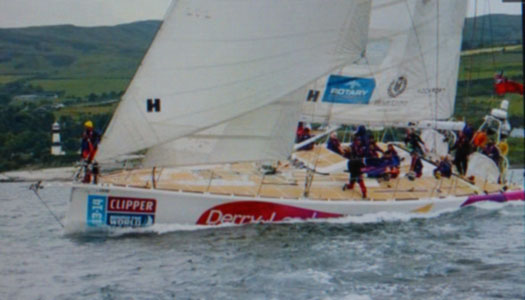
Home to victory – DLD making knots up Lough Foyle past the coast of Donegal
When the various pay-up-front round the world races were establishing themselves several decades ago, one noted newspaper sports editor famously agreed that they were the sporting equivalent of a fleet of tour buses full of paying passengers racing down the road from Dublin to Killarney. My own feeling was that a tour bus race would actually be great fun, but I could see the point that it was remote indeed from the purest concepts of sport.
Nevertheless the round the world operators have been whittled down over the years until the Clipper Race not only survives but actually thrives mightily, and has an image to die for. Far from being a specialised oddity, it is becoming mainstream. In Australia, the annual Sydney-Hobart Race struggles each year to get its entries above the hundred mark, so when the Clipper organisers suggested they might make Sydney-Hobart 2013 a leg of their course, the organisers – the prestigious Cruising Yacht Club of Australia – leapt at the chance. And as far as we're concerned in Ireland, it was a great success, as the Irish boat Legenderry, skippered by Sean McCarter of Donegal, was the winner of the Clipper division, while it was noted with added satisfaction that his hefty big "tour bus" had by no means been beaten by all the fancy out-and-out racing machines sailed by Hobart race veterans.

Sean McCarter aboard DLD – his class victory in the Sydney-Hobart Race made him the Afloat.ie "Sailor of the Month" for January.
But even in the best of all possible worlds, there is only so much in the way of resources for such events, and public attention is very limited and fickle. Yet in the end, public attention is what motivates sponsorship. For sure, in a small, specialised and intensely personal sport like sailing, there will always be a willingness by some company bosses to give a bit of help to a friend organising a sailing event. But at the very least it has to be something which can in some way be justified on the balance sheet, and with the increasing dominance of the ubiquitous accountant, and his or her need in turn to justify aspects of the company's behaviour to the tax inspectors, the old "helping out a mate" approach to sailing sponsorship becomes increasingly difficult to justify.
Yet although almost all sailing enthusiasts will give a bit of their attention to events like the Clipper Race and the Sailing Olympics, while even the most hidebound traditionalist will occasionally take a furtive note of what's going on in the snakepit of the America's Cup, the fact is that for most of us, sailing is still primarily a matter of sailing our own boat, or crewing with old shipmates on someone else's craft, and taking part in club racing and local regattas which to us are the essence of the sport.
But in terms of outside attention, even in the town or village attached to our own home ports such beloved sporting activity scarcely registers at all in a world in which round-the-clock sporting highlights are available on the media or in a nearby stadium virtually all the time.
Most of Irish sailing is all about what Edmund Burke called "the little platoons". While Burke recognised the inevitable and growing power of the big battalions, he promoted the ideal of the vital function of the little platoons – basically the family unit, the extended family, and their circle of friends – in holding society together and preserving civilised life.
So instead of mindlessly banging the drum about Ireland being a great place to sail, and endlessly repeating the mantra about the Royal Cork being the world's first proper yacht club – true and all as both may be – perhaps it's time to be realistic about our sailing situation, cherish what we have, and thereby build it to a healthy state.
Admittedly if you go overboard on being realistic, you can quickly become pessimistic and reduce all home sailing activity in recognition of the fact that many people's sailing ideal is a warm and sunny fortnight in Croatia or the Greek Islands, sailing boats whose care and maintenance is someone else's responsibility, and sailing moreover on waters which won't give you hypothermia after an hour's immersion.

The legendary American offshore racer Carina rounding the Fastnet Rock in the race of 2011. Carina will be one of many contenders in the Fastnet Race of 2015, but like most of the large fleet, it's unlikely she'll enter any Irish port.
But the perception elsewhere is that Ireland is quite a rugged place to sail. In fact, for many who briefly sail in our waters every other year, the ruggedness of our waters is the USP of the Fastnet Race. The biennial Grand National of offshore racing is now the epitome of a "big battalions" event. With the added kudos of the 1979 disaster in its history, having a Fastnet Race in your sailing CV is a globally-recognised distinction. Thus we can be quite sure that next year's race will see the enormous but limited entry list filled almost instantly, and equally we can be sure that the Irish economy will scarcely benefit at all from a huge event which uses our most iconic rock as the main mark of the course, the very symbol of an entire vast international event, yet the race starts and finishes in the south of England.
As to the perception of Ireland's weather and our sailing conditions, ten days ago I was up at Ballyholme Bay on Belfast Lough for the annual F18 World Championship. The F18 is a hugely popular catamaran which thrives as a class where sailing waters are in easy reach of large populations. Thus its biggest fleets are along the north and northwest coasts of France, but it's big in Holland and Germany too, and in the south of France and Italy it prospers mightily.

Belfast Lough produced some fine Irish summer sailing weather for the F18 Worlds, and at the same time the F17 Worlds in the south of France were being disrupted by severe gales. Photo: W M Nixon
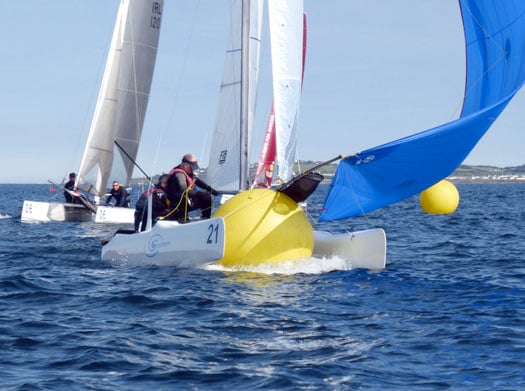
Whoops....it may have been a World Championship, yet there were some very human errors. But then, anyone accustomed to sailing a monohull could very easily forget you've a second hull to lee. Photo: W M Nixon
The 2013 Worlds in Italy attracted a fleet of 170 boats with thousands attending the opening festival. Then, as the well-run class has a policy of rotating the Worlds around countries which have a significant presence of F18s, the fact that it's the biggest catamaran class in Ireland saw the 2014 Worlds allocated to Ballyholme, Northern Ireland's premier dinghy club and a stronghold of F18 racing.
They knew that it would be wildly optimistic to expect a fleet to match Italy's lineup of 170 in 2013. But a target of a hundred boats seemed reasonable. Yet in the end they got 56. They'd great racing – much better than their smaller sisters the F17s which were being blown out of the water at the same time at their Worlds in the south of France. And with Gunnar Larssen of the Netherlands winning the title at his 13th attempt, there was a popular winner for a keen class of very pleasant people who were interesting and fun to be around.
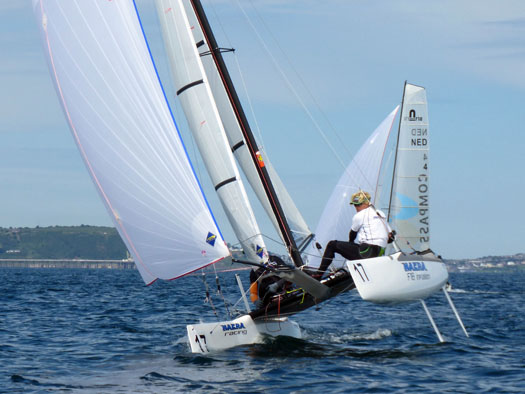
The F18s can be powered up in light breezes if you can get the weather hull clear.........Photo: W M Nixon

....and as the breeze builds, the hope is to have both crew on the wires......Photo: W M Nixon
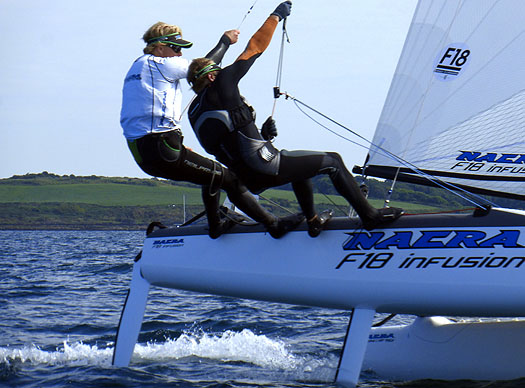
.....and then you're really cooking with gas. Photo: W M Nixon

It can be a knife edge. This may all look very relaxed, but it happened in jig time. Photo: W M Nixon
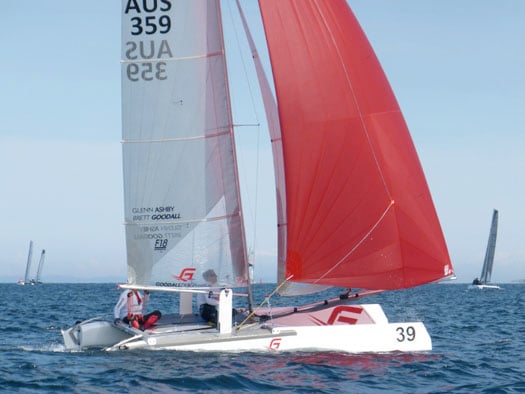
America's Cup rockstar Glenn Ashby of Australia was in the frame from time to time, but boat damage hindered his campaign. Photo: W M Nixon
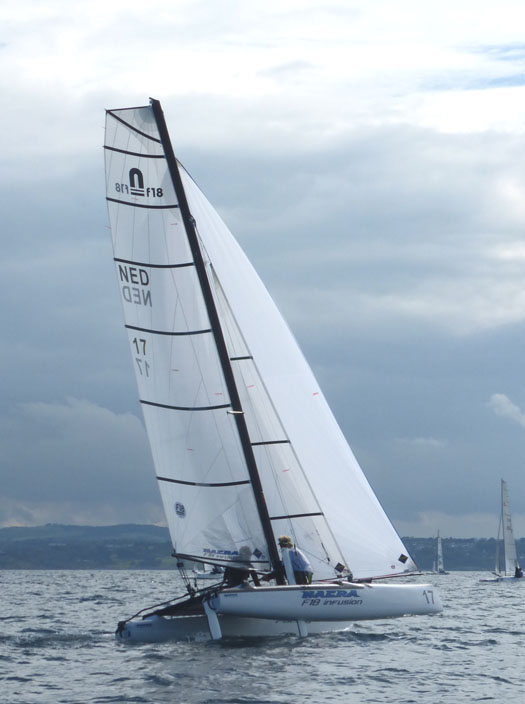
Despite his Viking name, new F18 World Champion Gunnar Larssen is Dutch. Here he gives a masterclass in winning out on a dead run (yes folks, this IS a dead run, but F18 style). Photo: W M Nixon

It was as the fleet came ashore that you realised the international nature of the entry. And the weather was Mediterranean, while in the Med itself, it was blowing a gale.....Photo: W M Nixon
As for a fleet of 56, it's more than enough to provide good sport, and they certainly had it. But it was a chilling – in every sense – reminder of the fact that, ever since Roman times, Ireland has been seen by the rest of Europe as Hibernia, the Land of Eternal Winter, and thus for the modern sailing world in general, we're seen as a small and distant island where only the most rugged would dream of going upon the sea.
Perhaps the turnout in any international event here could be directly calculated in relation to the distance of the venue from Mediterranean sailing conditions, qualified by the distance from Europe's main population centres. And lest anyone think that this compact turnout at Ballyholme was essentially to do with the special circumstances of Northern Ireland, at exactly the same time Cork Week saw numbers hovering around the hundred mark. And this in an event which fifteen years ago used to soar above five hundred.
It's a forceful reminded of how our sailing times are changing. If something is going to be very big in every way, then it can take up a lot of time and energy. But the old days of private owners divvying up resources and chivvying up crews in order to do a distant medium size regatta with all its logistical challenges seem to be a thing of the past, as the Scottish Series has also been finding out.
Yet if you visit every corner of Ireland, you'll be pleasantly surprised to find that on every coastline, any good anchorage is well filled with boats. After six years of economic stagnation, they may not be the newest boats around. But they're there in apparently greater numbers than ever, and they function happily in a strictly local environment.
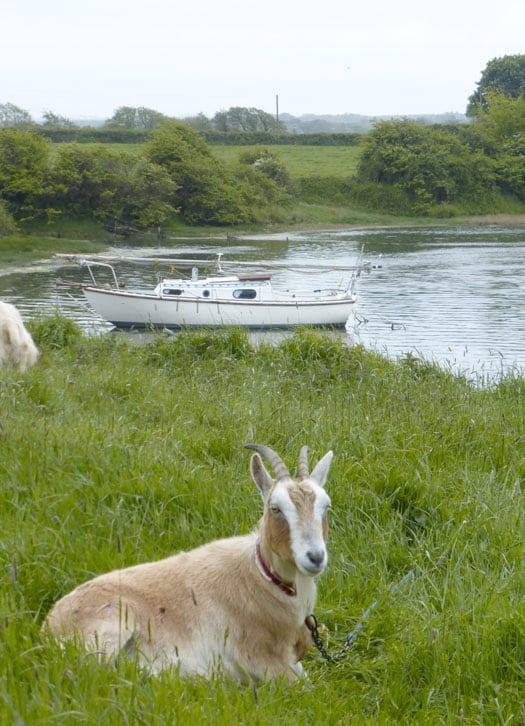
Ireland's hidden fleet (1). While getting a snap of this splendid goat at Ballylongford on the Shannon Estuary, we found our photo included a Macwester sloop, part of the growing local fleet in this remote inlet. Photo: W M Nixon
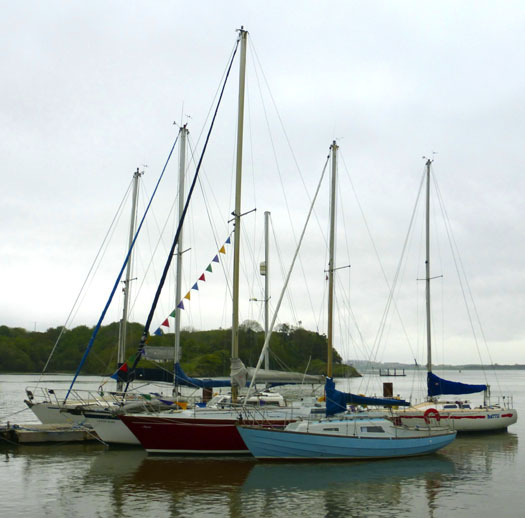
Ireland's hidden fleet (2). The cruiser-racers at Foynes YC have steadily increased in number for several years. This group includes two Irish-built boats on the right: an O'Brien Kennedy-designed Kerry, and a Ron Holland-designed Shamrock. Photo: W M Nixon
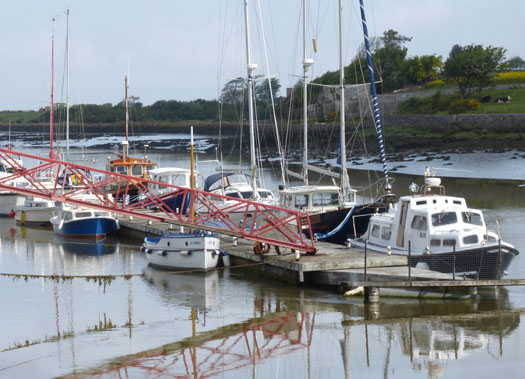
Ireland's hidden fleet (3). Up and down the Shannon, everyone will know of Askeaton in County Limerick, and Cyril Ryan's busy boatyard there. But who in the big outside world knows that this muddy creek is home to a fine fleet? Photo: W M Nixon
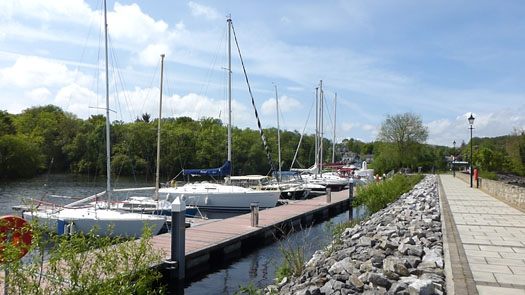
Ireland's hidden fleet (4). Talk of sailing on the Shannon lakes, and most folk will think of Lough Ree YC or Lough Derg YC, plus Iniscealtra SC at Mountshannon, and that's about it. But the extended harbour at Garrykennedy in Tipperary also has a fine fleet which wouldn't look out of place in a seaport. Photo: W M Nixon
It's something which will never be a headline-hitting sporting sensation, this quiet sailing enthusiasm of the little platoons. But it's there nevertheless, and as economic recovery picks up, who knows but we might be able to build it up into a slightly busier and better-supported sailing programme based on a realistic appreciation of the fact that while we may be a reasonably-sized island – the 30th largest in the world, to be precise – we're sparsely populated, we're relatively remote from the very big places, and we sail in a climate which can be rugged enough.
But as things get moving again, let's be realistic. There are grants available for clubs which wish to expand or develop their facilities. However, the message is: Don't simply think up some wizard scheme just to be able to avail of a grant. Instead, be realistic about what your really club and its membership really needs, and then -further down the line - see if it may be eligible for a grant. Such an approach will be to the benefit of everyone, and will help to build sailing's true image as a participant sport for all who are genuinely interested.
RoundIreland14 – It has been a classic Round Ireland Race. Just about everything except a gale, and even then there was some gear-breaking wind in the latter stages. But mostly, the sun shone. Or at least, there was little or no rain until Friday. And even if the wind didn't blow nearly enough, even those on the smaller boats who had committed a week's holiday time to this very special experience found they stayed within their leave limits, though only just.
When Wicklow farmer David Ryan confirmed in May that he had chartered the Volvo 70 Monster Project for the 2014 Round Ireland Race starting June 28th, he was succinct in his objectives. The bottom line was to support the Care For Shane campaign, which is raising funds for his nephew Shane Horgan, who was brain-damaged in a serious assault in 2012.
With the foundation of the plan in place, the details could be filled in. The Volvo 70 chosen was Russian, built in 2008 by Green Marine of Lymington. Owing to a shortage of funds during the race itself in 2008-2009, she didn't compete in all the legs. But once that race was over, here was this fine big Rob Humphreys design seeking a purpose, with time available to bring her up to standard. And she'd a new commercially-minded owner who cheerfully re-named the boat Monster Project, and worked on the basis of scouting out fresh fields for competition, as the Volvo World organisation was moving on to a new generation of boats in the next race.
But for round Ireland racing with fund-raising a priority, Monster Project ticked all the boxes. Nevertheless, Farmer Ryan was very realistic in his objectives. For sure, he hoped he might break the race's course record, which is a very different thing from the open round Ireland mono-hull record. But if he harboured even the slimmest hope of winning overall on corrected time, he kept it to himself. Yet he clearly stated that the main race objective was to win line honours – "first over the line for Shane". And at 18:25:25 hours on Wednesday July 2nd in a brisk southerly off the Wicklow pierheads with the enthusiastic support of the home crowd, Monster Project did that very thing.
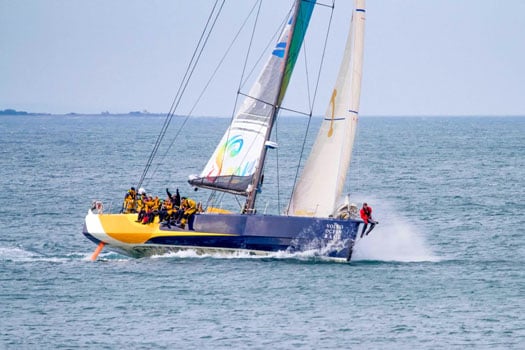
Job done. Monster Project takes line honours at Wicklow. Photo: Aidan Tarbett
As she was 70ft LOA and the next three biggest boats were "only" 60ft, it may have seemed a foregone conclusion. But the Round Ireland Race really is a case of swings and roundabouts and big dippers from time to time for every one of the 36 boats taking part. So though the Wicklow Monster may have built up a lead of 32 miles over the Open 60 Teng Tools Kilcullen (Eamon Crosbie & Enda O'Coineen) by the time she finished, she'd surely had to work for it. And had there been more fast off the wind stuff, things might have gone otherwise.
Despite the 10ft difference in length, the Open 60's potential is such that she rates an eye-watering 1.635 to the 1.6498 of Monster Project. So in rating terms the two boats were almost racing boat-for-boat, and in tactical terms that's the way Monster's 18-strong crew of all the talents had to see it.
But of course, with the predictions of light airs and calms for the first half of the week coming all too true, within 24 hours of the start it was becoming highly likely that one of the smaller boats would win, and low ratings became pearls beyond price. Observing it all and getting feedback from many sources, you became aware of the "Community of the Round Ireland Race" as the miles were slowly sailed. Their boats may have covered a wide variety of types and sizes, but the crews sharing this experience were joined together in a subtle way which gently but totally excluded outsiders.
You'd a sense of this in Wicklow as start time approached and the tension built up, with crews beginning to distance themselves from the shore crowds. Indeed, I got a blast of it in the car on the way down, listening to the Saturday morning's Down to Business programme on Newstalk, which is normally fronted by Bobby Kerr.
But as he was off to do the race on the fine big Farr 60 Newstalk for Adrenalin (chartered by Joe McDonald of the National YC), they'd a stand-in presenter. On the car radio, Kerr (a boat-owner himself) was trying to explain from the Farr 60 – with his usual zest – the special attractions of the Round Ireland Race to the American woman business journalist who was filling in for him in the studio. But he wasn't really making much progress. Her genuinely sceptical response to his enthusiasm for working coffee grinder winches and standing four hour watches 24 hours a day – and every chance of being called when you're off watch too – reminded me of the classic Bob Newhart sketch about the introduction of tobacco. The mutual incomprehension was just about total. And if Bobby Kerr can't explain the special attraction of racing round Ireland on his own radio show, then why do the rest of us even try?
The Round Ireland Race produces many imponderables. For instance, there's the matter of the new harbour and marina at Greystones finally hitting the headlines as a result of having Monster Project and Newstalk for Adrenalin based there in the leadup to the race, as Wicklow Harbour isn't really deep enough for them and both needed a pontoon berth.
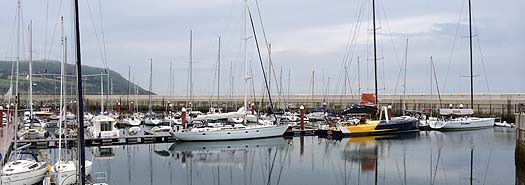
Arise, Greystones, and join the big time.....having Monster Project and Newstalk for Adrenalin in port pre-race raised Greystone's pofile something wonderful. Photo: Alan Corr
So Afloat.ie posted a pic from Alan Corr of Greystones Harbour showing the two biggies in port, and by sailing website standards it went viral. All because it's hashtagged #greystones. So be warned, in future you may find some very sleepy stories #greystones here on Afloat.ie if we hope to get them the Monster Newstalk level of attention.
But enough. Just as the sailor/spectator divide was beginning to manifest itself, I managed to get myself on board Wildwood for a quick recce. Not only was she the shortest entrant at just 30.5ft, but she was the newest with a build date of 2012. Yet in truth she was building since 2003, as this has been an extraordinary amateur design and build project, a case of good work done by stealth.
Though Wildwood sails from East Antrim Boat Club on Larne Lough, the first gleam of a notion came in the bar at Carrickfergus SC. Over a pint or three, amateur designer Richard McClure and can-do potential owner Ian Patterson sketched out ideas for a handy little dream performance cruiser-racer.
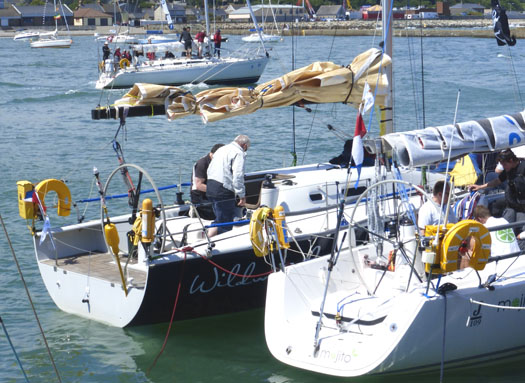
Little self-build 30-footer Wildwood (seen here outside the J/109 Mojito) came down from Larne to Wicklow for her first stab at the IRC big time. Photo: W M Nixon

Ian Patterson built Wildwood between 2003 and 2012, and they've won their class in the Scottish Three Peaks Race Photo: W M Nixon

Wildwood brought her shore support team – they came down from Larne with a couple of camper vans Photo: W M Nixon
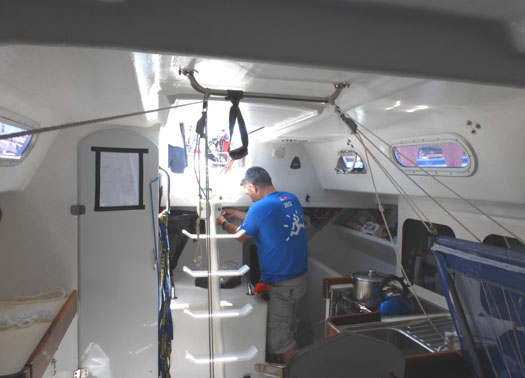
Below, Wildwood is roomy, with a highly individual layout Photo: W M Nixon

Wildwood has a substantial galley which wouldn't look out of place on a 40 footer. Photo: W M Nixon
It will be a good story to flesh out in more detail during the coming winter. Sufficient to say that she was launched in 2012 and arrived in Wicklow in June 2014 with honours already achieved by winning their class in last year's Scottish Three Peaks Race.
Nevertheless, despite the cheerful quayside support of family and friends who have stayed with the Wildwood project through its long gestation, the mood aboard was a bit subdued. The Scottish race had been on very basic handicaps, but the Round Ireland – which itself started in 1980 using a Wicklow modification of the ECHO system – is now part of the RORC programme, using strictly regulated IRC.
This new measurement routine put little Wildwood up from her notional rating of 1.02 to an official rating of 1.045. That may not seem like a huge jump, but for the crew of a little boat which prefers fast offwind stuff yet was going out to face a long beat right up Ireland's long Atlantic seaboard, it seemed like yet another mountain to climb.
But out they all go for the start, these 36 boats in all shapes and sizes, and any crewmember who denies abdominal butterflies at this time is either in denial, or so full of Stugeron they don't know what's going on below their navel.
With a decent nor'east breeze and a sluicing ebb running south, it's a tricky close reaching start at 1400 hours, but Teng Tools Kilcullen and serial overall winner Cavatina (Ian Hickey) are right there on time, and the only shunt in the body of the fleet is between western boats Lynx Clipper (Galway) and E F Collins/Amazing Grace (Tralee), with the latter returning to port to fix a fist-sized hole in her stern and set out again after some hours with a post-race protest in the offing.
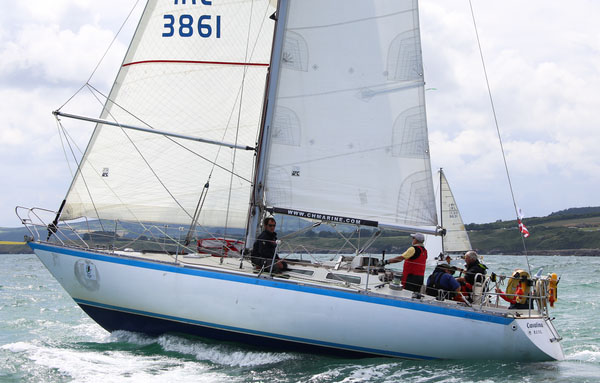
Out of the ruck of the start, the little Cavatina showed well among a raft of larger boats. Photo: David O'Brien
Coming out of the start, with boats which would emerge as performers as the race went on starting to show themselves. The Sydney 36 Tanit is left foreground, the Rodman JV 42 Phosphorus (Mark Emerson) is making hay with Code 0, the "steady Eddy" Ker 39 Inis Mor is right front, and the big Farr 60 Newstalk for Adrenalin is starting to show a performance which just kept getting better throughout the race. Photo: W M Nixon
Thanks to the Yellowbrick plotters, following the fleet has become like a computer game. If you're bored with the progress, you can always accelerate them electronically up and down along the course, with it all becoming – as the less reverent have remarked – like a pack of rats trying to get up a drainpipe.
It's when you see it reduced to symbols on a screen in the big picture that you realise how restrictive the round Ireland is for epic tactical gambles. In the Newport-Bermuda race, for instance, the 600 miles of straight line across the open ocean provides a broad canvas, and the famous Carina once notched one of her legendary wins by being all of 60 miles to the westward of the rhumb line. But in the round Ireland, only along the south coast is there a decent option for taking a real flyer, and it was there south of Youghal that Teng Tools went offshore as the wind drew sou'westerly, while the nearby and faster-to-windward Monster Project went off to close the land and cover the French Volvo 60 Libertalia and Newstalk for Adrenalin.
Monster put those two well away, but at the Fastnet she was only 20 minutes ahead of Teng Tools Kilcullen shortly after noon on Sunday, TTK coming sweetly in from seaward and doing very well in conditions which didn't really suit her at all.

Teng Tools Kilcullen at the Fastnet 21.5 hours after the start. Photo: Paul O'Flynn
In fact, if you'd set out to design a race which didn't at all suit an Open 60, then the 2014 Round Ireland would be in the top five. An awful lot of light windward work, and gates at every turn. In these conditions, a Volvo 70 is more flexible, but even so on Tuesday as Monster sat stopped off Inishtrahull, TTK was close to the southwest and energetically tacking inshore along the north coast of Donegal against a local easterly, keeping herself well in touch.
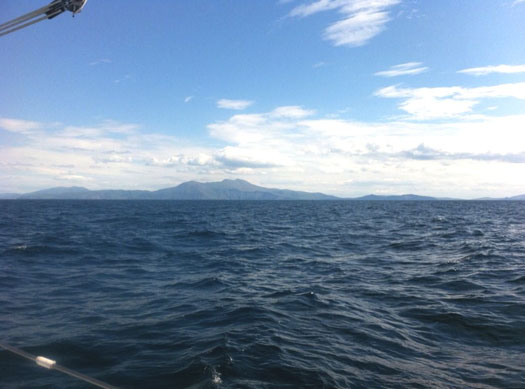
Fine day out west – the Kerry coast with the Blaskets as seen from Liam Shanahan's J/109 Ruth

Good morning, Ireland. The Scottish Sydney 36 Tanit (Richard Harris) enjoys a summer sunrise on the Atlantic coast, even if they do have to turn to windward. Photo: Roisin Harris

Even with all June's sunshine, the North Atlantic was distinctly chilly for this swim from the First 40 Arthur Logic

Downtime on the Sydney 36 Tanit out in the Atlantic. Owner Richard Harris sails under the burgee of the Serpent YC, a Scottish club founded in 1976 for sailing health professionals. Photo: Roisin Harris
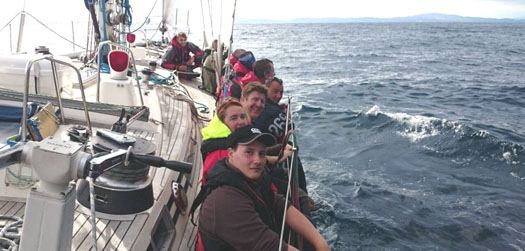
All hands to the lee rail to get a bit of heel on the hefty Swan 57 Bow Waves Racing from Galway as she makes slowly to windward off the Atlantic coast.
The two biggest boats then had an awful lot of hard work tacking through the North Channel, but astern Newstalk was getting into the groove, and by the time Monster was finishing the Farr 60 had seen off the Volvo Ocean 60, and was giving TTK a bad time.
With the new southerly filling in with gusto, the little boats still off the Donegal coast were making hay, with Cavatina coming in round Tory Island well up with the Swan 57 Bow Waves from Galway. Cavatina's crew were having the time of their lives and living well with it – they tweeted the cooking spuds which power the boat, presumably with buckets of Barry's tea. However, until Donegal the talking point had been the impressive game of catch-up being played by Brian O'Sullivan and his Tralee Bay crew in the Oyster 37 E F Collins/Amazing Grace, as they were ninth overall in IRC at one stage, and of course if their protest was upheld post-race, Heaven only knows what compensatory time would be added.

Grub up! In many years of successful Round Ireland racing, Cavatina's crew have learned the importance of feeding the inner man.
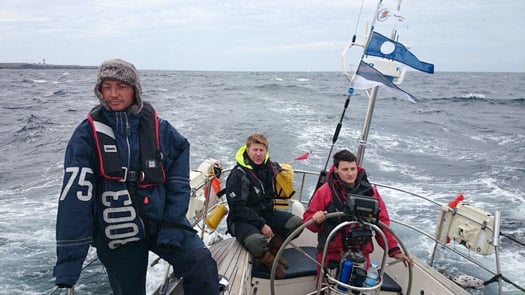
The brisk new sou'wester brought the Swan 57 Bow Waves Racing sweeping in past Tory Island, but she'd the much-smaller Cavatina in sight astern.
But that spirited performance ended with a bang on Wednesday with a broken mainboom which, together with other problems, led to their withdrawal. However, there were plenty of others to take their place in challenging for the overall lead, with Liam Shanahan and his crew from the National YC in the J/109 Ruth getting themselves firmly ahead of Frank Doyle's A 35 Endgame from Cork, while the attractive Sydney 36 Tanit from Scotland was also very much in the running.
Looking at the fleet overall as they made along the Donegal coast, there were discernible patterns emerging, with boats you'd call the "solid performers" starring on the track chart. These were boats such as Inis Mor, Tanit and Ruth which always seemed to be there or thereabouts, always plugging away and showing a clean pair of heels to the nearest-rated boats, and always well placed such that if local wind and tide conditions favoured them, they were poised to ascend rapidly to the top of the leaderboard.
As for the "sail training" vessels, in the closing stages the Jeanneau Sunfast 37 Desert Star of Irish Offshore Sailing at one stage on Wednesday found herself lying second overall to Cavatina. But with 170 miles still to go, and most of them to windward, it was going to be hard work for a keen multicultural crew of many nationalities to maintain this exalted placing.
It was Thursday morning which was crunch time. Having filled in from the south, there was a brief period in which the wind veered towards the west, and with Monster Project well finished and then Teng Tools Kilcullen, Newstalk for Adrenalin and Libertalia finishing during the night, first light saw the steady and reliable Inis Mor finishing at 04:13:56 to stake a claim which was challenged by boats such as Tanit and Ruth closing up from astern in a now-favourable tide, the tide having been against Inis Mor all the way down from Rockabill except for the last hour or so.
The challenge from a hundred miles away of Cavatina faded for a while with light airs off Belfast Lough and a foul tide in the North Channel. But in the south end of the Irish Sea and through St George's Channel, the sou'west to west breeze was holding enough to have Tanit and Ruth moving theoretically into the top slots ahead of Inis Mor. But then with the tide turning again to run north around 0900 hrs, it was to be nail biting stuff through Thursday morning.
Tanit was in by 10:00:44 hrs on Thursday, leaving the lower-rated Ruth with a mountain to climb, the tide against her and the breeze light. It was excruciating to follow, with her speed down at times to barely a knot over the ground off Greystones, and the lovely Wicklow coastline just crawling past at snail's pace. Meanwhile, far astern Cavatina was back in business with just 80 miles to sail, and a local breeze giving her better than 5 knots on the clock.
Meanwhile by 1300hrs Ruth had just 5 miles to go, and speed slowly building as the wind was generating around big clouds over Dublin.
But by just after 2pm Thursday it was clear Tanit had pipped Ruth for the clubhouse lead. Ruth had looked all set to be the leader until a cruel combination of decreasing wind and increasing adverse tide held her up within sight of the Wicklow finish. Tanit, safely in the club, knew that any setback to Ruth's progress would establish them as the target boat for the rest of the fleet. Wicklow Sailing Club could not formally announce the winner until much later on Friday as the last of the boatts finished but it was clear not even Cavatina who had until 2am on Friday could match the time of the Scottish Sydney 36.
They and all the other competitors will have this weekend to decompress and try to explain to family, friends and workmates just what this crazy Round Ireland Race thing is all about. But it isn't until the great prize giving dinner in Wicklow in the Autumn that they can all really tell the stories that just have to be told, and tell them to people who will really understand.




































